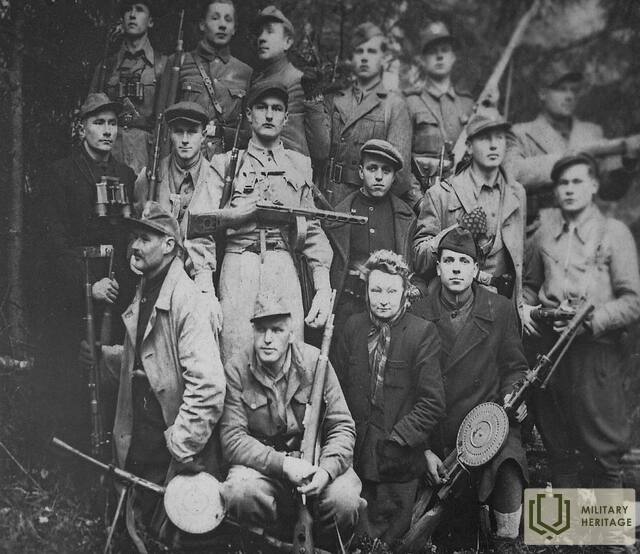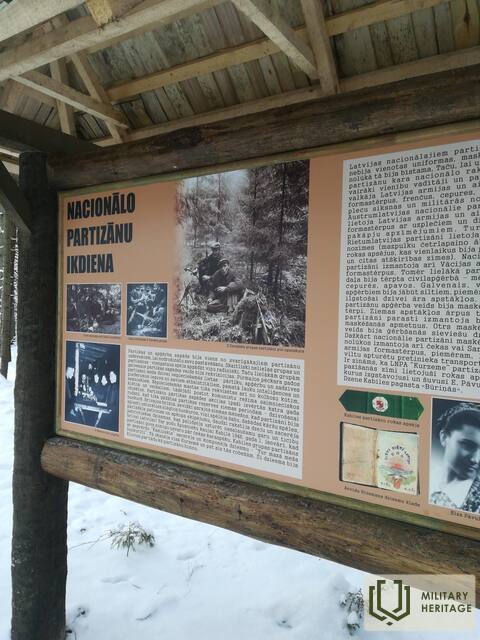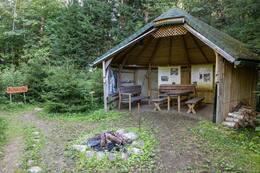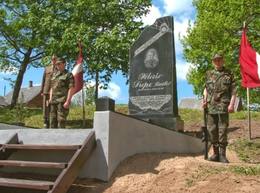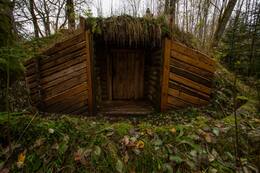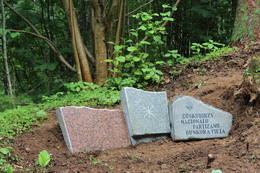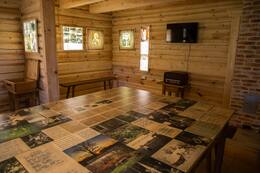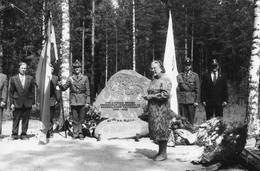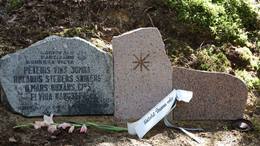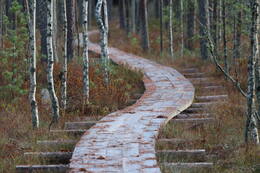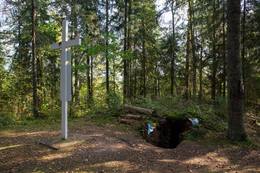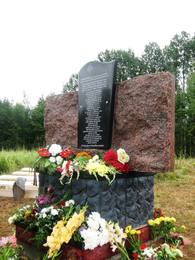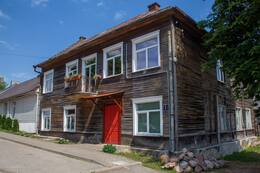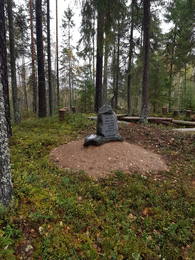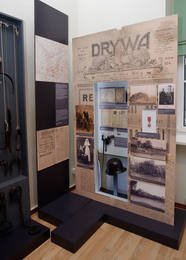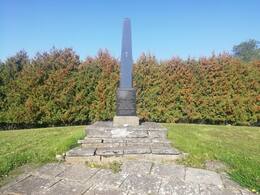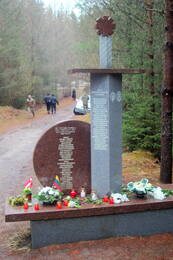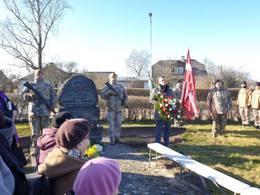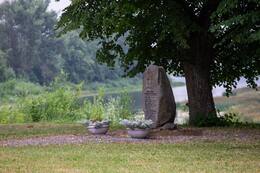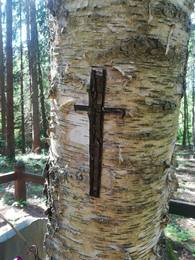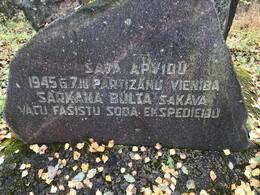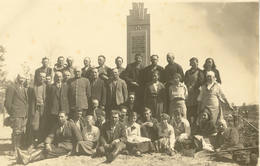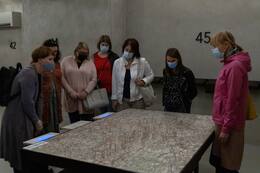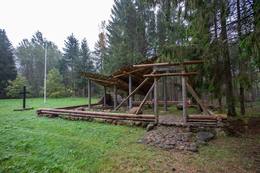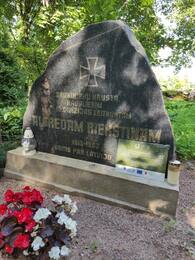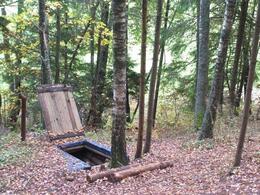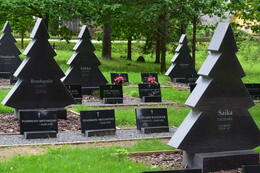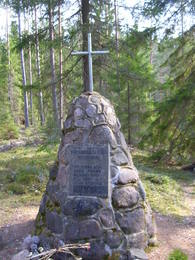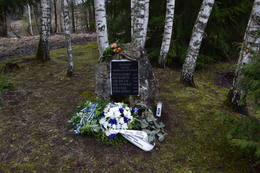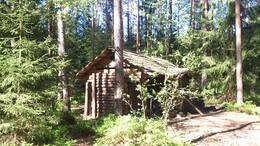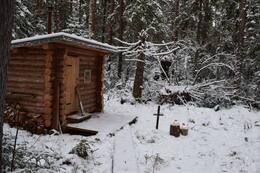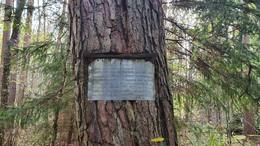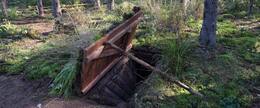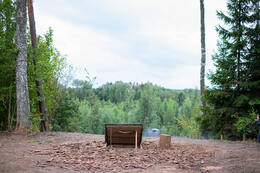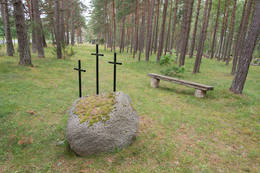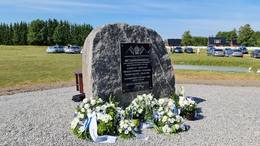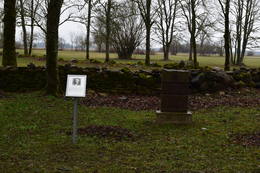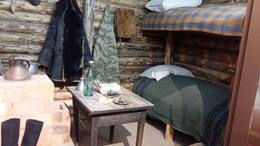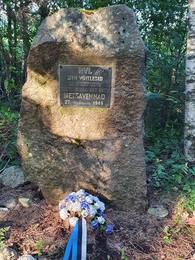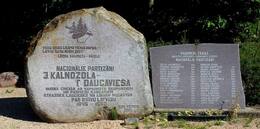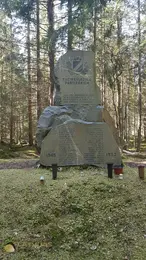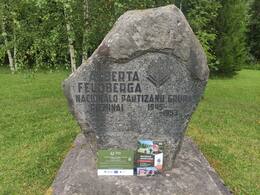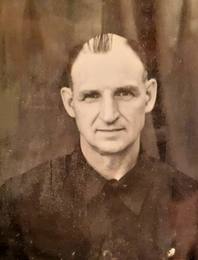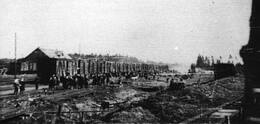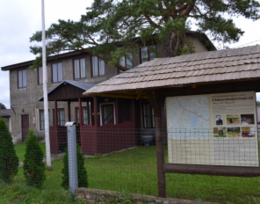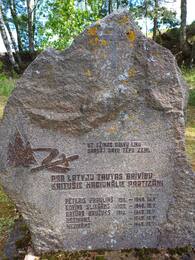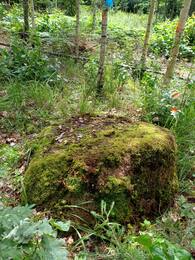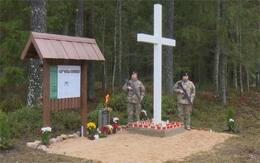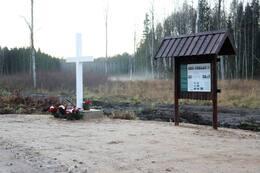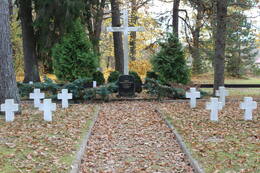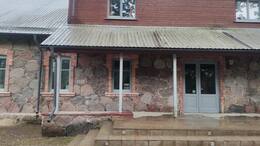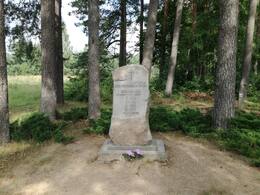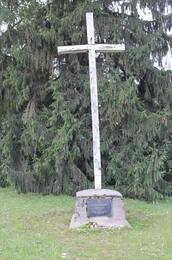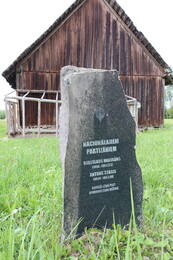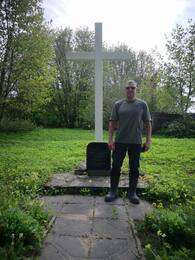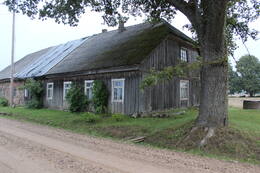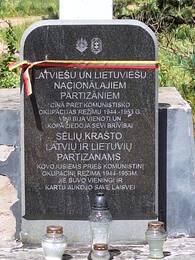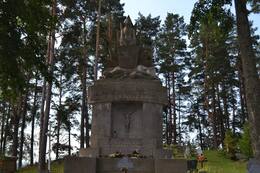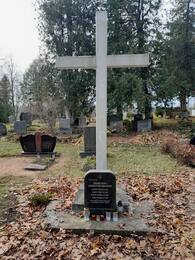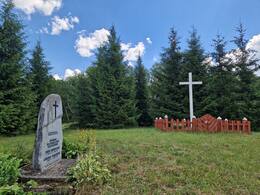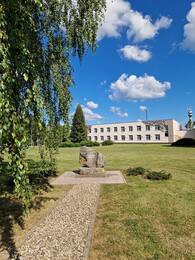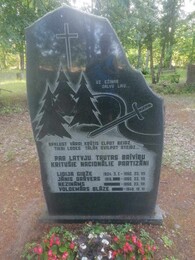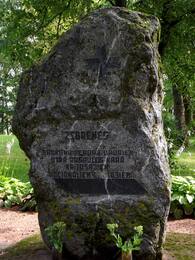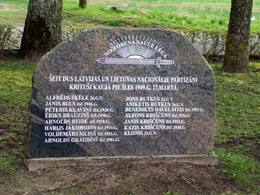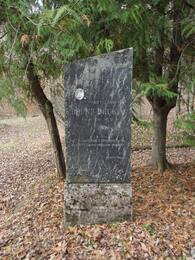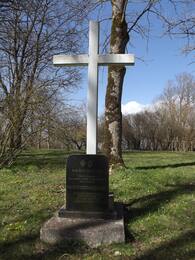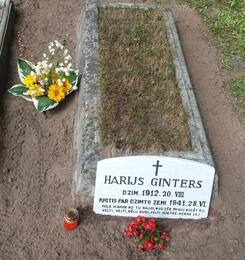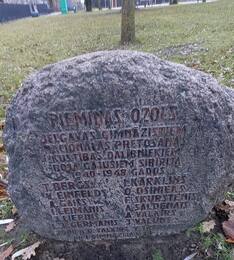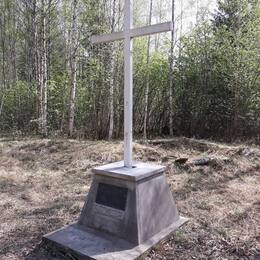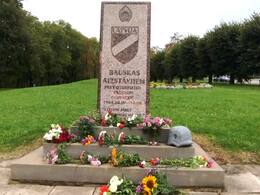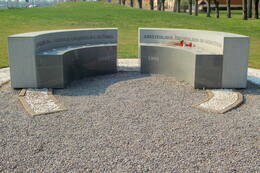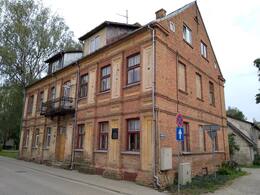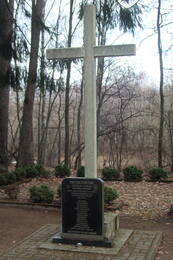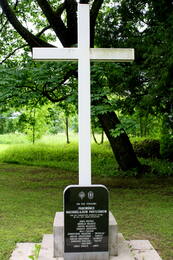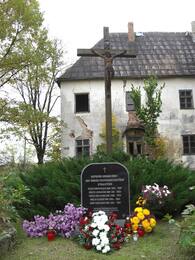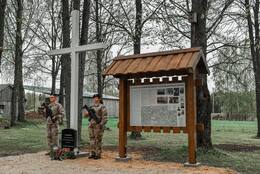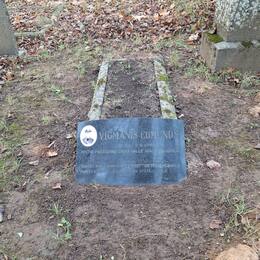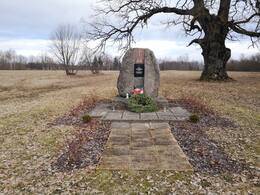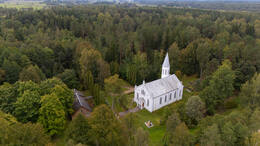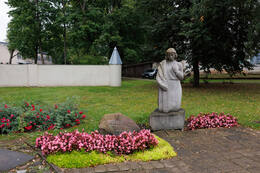Mežabrāļi vai Nacionālie partizāni
II WW2, III Nacionālie partizāni
Die nationalen Partisanen oder Waldbrüder waren kleine, bewaffnete Gruppen von Einheimischen, die von 1944 bis 1956 auf dem Gebiet Lettlands ihren unabhängigen Kampf gegen das Besatzungsregime der UdSSR führten.
Es handelte sich um Menschen, die sich in den Wäldern verstecken mussten und nicht in der Sowjetunion leben konnten oder wollten. Es handelte sich um Einwohner Lettlands, die von August 1944 bis Mai 1957 das Besatzungsregime der UdSSR durch bewaffneten Kampf und Partisanenkrieg bekämpften.
Die Partisanenkämpfe mit den Truppen des Besatzungsregimes fanden ab Spätsommer 1944 statt.
Insgesamt gab es in Lettland etwa 20193 Waldbrüder/ nationale Partisanen.
Papildus izziņas avoti
Lettische nationale Partisanenkämpfe - Nationale Enzyklopädie (enciklopedija.lv)
Saistītās laikalīnijas
Saistītie objekti
Mežabrāļi – nacionālo partizānu bunkurs
Izveidots partizānu bunkurs, kurā var mazliet piedzīvot partizānu sajūtas, apskatīt partizānu personīgās mantas, ieročus, fotogrāfijas. Stāsti un atmiņas filmās par nacionālo partizānu cīņu pēc 1945. gada.
Latvijas nacionālie partizāni jeb mežabrāļi bija mazas, bruņotas vietējo iedzīvotāju grupas, kas patstāvīgi cīnījās pret PSRS okupācijas režīmu Latvijas teritorijā no 1944. līdz 1956.gadam. Tie bija cilvēki, kuri nevarēja vai nevēlējās dzīvot Padomju savienībā un bija spiesti slēpties mežos. Kopā Latvijā darbojās apmēram 20193 mežābrāļi.
Bunkurs izveidots, izmantojot bijušo mežabrāļu stāstus un atmiņas par dzīvi mežos, slēpjoties un cīnoties par neatkarīgu Latvijas valsti. Bunkurā iekārtota bruņojuma un sadzīves priekšmetu ekspozīcija. Gida stāstījumu papildina video ar mežabrāļu intervijām.
Bunkura ārpusē ir iekārtota piknika vieta ar ugunskura.
Var iepriekš pasūtīt uz uguns gatavotu zupu vai pavadīt vakaru pie ugunskura, skatoties āra kino.
Patstāvīgi pieejama partizānu taka. Bunkura apskate pēc iepriekšējas pieteikšanās.
Nacionālo un padomju partizānu cīņu un piemiņas vietas Grīvas meža masīvā
Atrodas Grīvas meža masīvā.
Apskatāmi seši objekti, kas saistīti ar nacionālo un padomju partizānu cīņu vietām.
Grīvas mežu masīvā atrodas ne tikai “Purvsaliņu” nacionālo partizānu mītnes, Baltais krusts nacionālo partizānu bunkurā un krusts pretestības kustības komandierim Andrejam Roskošam, bet arī padomju partizānu brigādes komandiera Artūra Baloža kaps, piemineklis tā dēvētajā Meiteņu kalniņā, kurā 1944. gadā gāja bojā padomju partizānu brigādes jauno partizānu grupa, kā arī monuments padomju partizāniem ar piecstaru zvaigzni un iegravētiem vārdiem “Kaut skujām sevi sedzām”.
Objektus iespējams arī apskatīt dodoties izbraucienā ar divriteni velomaršrutā Nr. 785 - "Vēstures atskaņas Grīvas mežos" (maršruta garums 34 km, grants un meža ceļi). Karte lejupielādei.
Piemiņas vieta nacionālo partizānu grupas komandierim Andrejam Roskošam (GPS 56.87399, 27.43524)
1997. gada rudenī Lielgrīvas mežā atklāts Baltais krusts nacionālo partizānu grupas komandierim Andrejam Roskošam.
Piemineklis Artūram Balodim (GPS 56.872926, 27.478121)
Artūrs Balodis bija padomju partizāns, īpašo uzdevumu komandieris A apakšvienībai, kura mitinājās Grīvas mežu masīvā. Krita apjomīgajā “ķemmēšanā“, ko veica nacistiskās Vācijas okupanti. Kaujasbiedri vietā, kur viņš gāja bojā, bērzā iegrieza burtus AB, lai to neaizmirstu. Pēc kara novadpētnieki iezīmēto bērzu atrada un tai vietā uzstādīja piemiņas plāksni.
Visiem Grīvas mežos kritušajiem (GPS 56.863280, 27.47975)
Šo piemiņas akmeni Grīvas mežu masīvā ir uzstādījuši VAS “Latvijas valsts meži” par godu partizāniem, kuri cīnījās par savu dzimteni. Blakus piemiņas akmenim ir karte-shēma ar partizānu mītņu – apskates objektu norādēm. Ir ierīkota arī atpūtas vieta. Netālu atrodas nacionālo partizānu apmetnes vieta, 1945.-1947.gads.
Nacionālo partizānu apmetnes vieta (GPS 56.863456, 27.481148)
Šai vietā atradās nacionālo partizānu, kuri cīnījās pret padomju okupāciju, apmetnes. Ir saglabājušās atsevišķu bunkuru vietas, pēc kuru vizuālā izskata var spriest, cik lielas un kādas formas bijušas zemnīcas. Nacionālie partizāni, pretojoties padomju varai, Grīvas mežos darbojās vairākus gadus pēc otrā pasaules kara beigām.
Grīvas mežu memoriālais ansamblis, zemnīca (GPS 56.860665, 27.490439)
Uzcelts par piemiņu padomju partizāniem, kuri mitinājās Grīvas mežos. Partizāni spridzināja vietējo dzelceļu tīklu un vilcienu sastāvus, lai traucētu nacistiskā Vācijas armijas munīcijas, pārtikas u.c. piegādei. Vietās, kur kara laikā bija izraktas zemnīcas, ir novietoti piemiņas akmeņi. Atjaunotajā zemnīcā var izjust kara laiku atmosfēru.
Meiteņu kalniņš (GPS 56.858187, 27.521526)
1944. gada jūnijā nacistiskās Vācijas okupanti veica plašu Grīvas mežu “ķemmēšanu“ ar nolūku iznīcināt partizānus. Karavīri uz Numernes kalniņa aplenca saimniecisko rotu, kurā pārsvarā bija jaunas meitenes, un visas tika nošautas. Kopš šiem traģiskajiem notikumiem Numernes kalniņu vietējie iedzīvotāji pārdēvēja par Meiteņu kalniņu. Šajā vietā ir uzstādīts piemiņas akmens.
Denkmal für den Kommandanten der nordöstlichen nationalen Partisanen Pēteris Sup - "Cinītis"
Zu Ehren des nationalen Partisanenkommandanten Pēteras Supes wurde am 28. Mai 2005 in Vilakas ein ihm gewidmetes Denkmal enthüllt. Es befindet sich in der Nähe der katholischen Kirche von Viļaka, am Rand der während des Krieges ausgehobenen Schützengräben, in denen die Tschekisten die erschossenen nationalen Partisanen begraben haben. Eine Kapsel mit den Namen von 386 gefallenen nationalen Partisanen, Kampfbeschreibungen und Materialien über den Partisanenkommandanten befindet sich unter dem P.Supem gewidmeten Denkmal. Die in Stein gemeißelten Worte: "Ich bin dir, Lettland, bis zu meinem letzten Atemzug treu geblieben".
Das Denkmal wurde von Pēteris Kravalis geschaffen.
Daneben befindet sich eine Gedenkstätte im Stompaki-Wald und andere Kampfstätten für lettische Freiheitskämpfer, die in den Jahren 1944-1956 von den Tschekisten gefallen und ermordet wurden.
Am 20. Juni 2008 wurde an der rechten Wand eine Granittafel mit den Namen von 55 gefallenen Partisanen in drei Spalten entdeckt.
Das Denkmal wurde an der Stelle errichtet, an der einst die kommunistischen Besatzungsbehörden die Überreste der ermordeten Partisanen zur Einschüchterung der übrigen Bevölkerung zur Schau stellten.
Auf der nebenstehenden Tafel sind Dankesworte an Pēteris Supe und ein Gedicht von Bronislava Martuževa eingraviert:
"Steh auf, Peter Supe,
Seele, im Kampf!
Heute Dein Blutopfer,
Auferstanden in der Nation.
Geh hinaus, um für immer zu leben
In der Kraft und Kraft der Jugend,
Wickelt, flattert, faltet sich
In der steigenden Flagge!"
Erinnerungsstätte für die nationalen Partisanen von Sērmūkši mit Unterstand
In Sērmūkši befindet sich eine der mehr als einhundert Partisanen-Erinnerungsstätten in Lettland. Insgesamt fanden an mehr als sechshundert Orten in Lettland Partisanenkämpfe statt. Der nach historischen Vorbildern erbaute Unterstand lettischer nationaler Partisanen bietet nach vorheriger Anmeldung Übernachtungsmöglichkeiten - Holzpritschen, Petroleumlampen und Heizen wie zu Zeiten der Partisanen. Das Schicksal ereilte die Gruppe der nationalen Partisanen von Sērmūkši am 29. November 1946, als vier Kämpfer der Gruppe fielen - Jānis Zīrāks, Reinholds Pētersons, Jānis Pīlands, Anna Zariņa. Alfrēds Suipe entging diesem Schicksal. Er überlebte auch die Deportation, kehrte nach Lettland zurück und erlebte die Wiedergeburt des freien Lettland. Auf seine Initiative hin entstand diese Erinnerungsstätte für seine gefallenen Kameraden in Sērmūkši.
Gedenkstein für die nationalen Partisanen der Pfarrei Alsviķi „Schlangenplatz“
Befindet sich in "Čūskubirzs", Gemeinde Alsviķi, Bezirk Alūksne.
Der Gedenkstein wurde am 21. August 2018 enthüllt. Akmeņkalis Ainārs Zelčs.
Hier im Waldmassiv ist eine Bunkeranlage erhalten geblieben, wo im Juni 1947 der Leiter der Kommunikationsabteilung des Lettischen Nationalen Partisanenverbandes Antons Circāns zu einem Treffen mit den Partisanenvertretern unter der Leitung von Bruno Bucalder kam, um Kontakte zwischen bestimmten Gruppen zu organisieren und aufrechtzuerhalten nationale Partisanen. Das Ziel von Anton Circan wurde nicht erreicht, denn am 7. Juli 1947 starb er in der Nähe von Drusti.
Gedenktafel für die nationalen Partisanen von Veclaicene anstelle eines Bunkers
Befindet sich in der Gemeinde Veclaicene, Region Alūksne.
Eröffnet am 4. Oktober 2019. Akmeņkalis Ainārs Zelčs.
Am 13. März 1953 öffneten die Tschekisten in den Wäldern von Veclaicene, unweit des Koruļi-Hauses, einen sorgfältig getarnten Bunker und verhafteten Bernhard Ābelkok und Elmārs Tortūze.
Im Bunker wurden Waffen gefunden: 2 deutsche Gewehre und 95 Patronen, 2 Parabellum-Pistolen und 152 Patronen.
Am 11. November 1949 wurde der tschechische Agent K. Dokti-Doktenieki erschossen und seine Gruppe aufgelöst. Nach dem Angriff versteckten sich B. Ābelkoks und E. Tortūzis einige Zeit in einem Bunker in der Nähe des Maskaļi-Hauses, aber ab dem Frühjahr 1951 bauten sie mit Unterstützung von Ilona Ābolkalns einen Bunker in Koruļi, wo sie bis zu ihrer Verhaftung lebten .
Gedenkmuseum für Broņislava Martuževa - Poesiescheune
Das Broņislava-Martuževa-Museum befindet sich an der Stelle des Geburtshauses der Dichterin in der Gemeinde Indrāni im Landkreis Madona. Es ist in einer renovierten Scheune untergebracht, die Audio- und Videoaufzeichnungen als Zeitzeugnisse der Widerstandsbewegung birgt und über ein von ihr erstelltes Untergrundjournal mit Gedichten und Liedern für die nationalen Partisanen Zeugnis ablegt. Broņislava Martuževa war von Anfang an in der Widerstandsbewegung aktiv. Der nicht erhaltene Hof der Martuževs namens “Lazdiņas“ war auch Zufluchtsort für den Anführer des lettischen nationalen Partisanenverbandes, Pēteris Supe, und seine Kameraden. Hier versteckte sich die Dichterin fünf Jahre lang im Keller ihres eigenen Hauses, traf Partisanen, schrieb Gedichte (darunter Widmungen für die Partisanen Pēteris Supe, Vilis Tomas, die Smilga-Gruppe, Laivenieks, Salns, Celmiņš, Bruno Dundurs usw.), schrieb Lieder und brachte sie den Partisanen bei. Heute werden ihre Lieder von der Gruppe „Baltie lāči“ gesungen. 1950 gab sie im Untergrund zusammen mit Vilis Toms die Zeitschrift „Dzimtene“ heraus. Die Dichterin hat die 11 Ausgaben mit jeweils 10 Exemplaren per Hand abgeschrieben. 1951 wurden die Dichterin, ihr Bruder, ihre Schwester, ihre Mutter und Vilis Toms verhaftet. 1956 kehrte Broņislava Martuževa aus Sibirien zurück. Die Poesiescheune ist sowohl in der Region als darüber hinaus bekannt und wird sowohl von Einheimischen als auch von Auswärtigen gerne besucht. Der Lebenslauf der Dichterin spiegelt das Schicksal Lettlands exemplarisch wider.
Мемориал павшим воинам Латышского легиона и национальным партизанам
Расположено в приходе Индрани, на Новом кладбище Лубаны.
Памятник павшим воинам Латышского легиона и национальным партизанам можно увидеть
Мемориал был открыт 25 июля 1992 года. Памятный камень создал Андрис Бриезис.
В начале Пробуждения, в октябре 1990 года, Карлис Доропольскис, член правозащитной группы «Хельсинки 86», получил разрешение властей возобновить совместное захоронение латышских легионеров на кладбище братьев, которое было устроено на новом кладбище. Лубаны. Всего на братском кладбище похоронено 26 павших легионеров и национальных партизан.
Nacionālo partizānu grupas “Jumba” bunkura piemiņas vieta
Atrodas Ziemera pagastā Valsts mežu 66. Kvartālā.
Piemiņas vieta atklāta 2020. gada 10. jūlijā.
Latvijas nacionālo partizānu kustības otrajā posmā, 1948. gada vidū, 4 cilvēku grupa- Viks Pētersi, Stebers Rolands, Bukāns Ilgmārs un Kangsepa Elvīra atdalījās no J. Bitāna- Liepača vienības Mālupes- Bejas pagastu teritorijā un uzsāka patstāvīgu darbību Ziemera-Jaunlaicenes- Veclaicenes pagastos. Partizānu mītnes vieta bija Igaunijas robežas tuvumā, netālu no Rīgas- Pleskavas šosejas, uzkalniņā, pamatīgi izbūvētā bunkurā.
1950. gada 2. martā, kad čekisti atklāja bunkuru, partizāni paslēpās Igaunijas pusē “Napkes” mājās no laukakmeņiem celtā šķūnī. Pēc ilgas un intensīvas apšaudes 1950. gada 3. martā čekistiem izdevās šķūni aizdedzināt. Ilgmārs Bukāns, Rolands Stebers un Elvīra Kangsepa kopā ar jaundzimušo meitiņu sadega. Pēteris Viks izlēca pa šķūņa logu un paslēpās mājas bēniņos, kur viņu arī atrada un nošāva. Saimniecību nodedzināja. Visu kritušo partizānu ķermeņus nogādāja Alūksnē. Cīnītāju bojāejas vietā 1990. gadu sākumā uzstādīja piemiņas zīmi. Elvīras Kangsepas degošajā šķūnī dzimušajai meitiņai deva vārdu Liesma.
Nacionālo partizānu mītnes dabas liegumā “Stompaku purvi”
Dabas liegums “Stompaku purvi” ir unikāla ar savām dabas bagātībām un kultūrvēsturisko mantojumu. Izstaigājot dabas liegumu “Stompaku purvi”, kas ir iekļauti NATURA 2000 teritorijā uzzināsiet gan par teritorijā mītošajiem putniem, dzīvniekiem un augiem, gan arī pa labiekārtotu marķētu taku nokļūsiet līdz purva salām, kur Otrā Pasaules kara laikā bija ierīkota viena no lielākām nacionālo partizānu nometnēm Baltijā.
1945. gada sākumā Stompaku nometnē, sauktā par “Saliņu mītnēm” bija izvietota nacionālo partizānu bāze, kurā dzīvoja 350–360 cilvēki, tostarp 40–50 sievietes. Nometnē bija 24 dzīvojamie bunkuri – līdz pusei zemē iedziļinātas būves, kurās varēja dzīvot 3–8 cilvēki. Nometnē bija arī sava maizes ceptuve, kurā regulāri cepa maizi un baznīcas bunkurs, kurā katru dienu notika dievkalpojumi, kā arī trīs virszemes slieteņi zirgu novietnēm. Sākot ar janvāri no nometnes partizāni regulāri veica uzbrukumus okupācijas režīma amatpersonām.
1945. gada 2.–3. martā šeit notika Stompaku kauja – lielākā kauja Latvijas nacionālo partizānu vēsturē, kur nometnē izvietotajiem 350–360 partizāniem uzbruka NKVD 143. strēlnieku pulks un vietējā istrebīķeļu bataljona kaujinieki, kopskaitā 483 vīri. Kauja risinājās visu 2. marta dienu. Naktī uz 3. martu partizāniem no nometnes izdevās izlauzties un tie devās uz savām iepriekšējām bāzēšanās vietām. Partizāni bija zaudējuši 28 kritušos un no ievainojumiem mirušos, bet NKVD karaspēks 32 kritušos un mirušos.
Mūsdienās nometnes vietā var apskatīt trīs atjaunotos bunkurus – baznīcas štāba un vienu dzīvojamo bunkuru, kā arī 21 bijušo bunkuru vietu bedres. Ir izvietoti trīs informatīvie stendi, kuri stāsta par nometni un kauju.
Ir iespēja pieteikt ekskursijas grupām gida pavadībā.
Vesetas partizānu zemnīca un piemiņas vieta "Baltais krusts"
Apskatāms izgatavots un uzstādīts 3 m augsts krusts baltā krāsā plāksnes ar 1946. gada 2. jūlijā nošauto Latvijas nacionālo partizānu vārdiem. Turpat blakus atjaunota zemnīca. Lai vieglāk būtu šo vietu atrast, no Vietalvas puses uzstādīta norāde ar uzrakstu “Baltais krusts”.
Otrā pasaules kara laikā Vietalvas apkārtnē risinājās aktīva kara darbība, un ar to saistīti arī notikumi pēc kara beigām. Pēckara gados te darbojās tā saucamā “Pārupa grupa”, kuras vadītājs bija Rihards Pārups (1914 - 1946) .
1946. gadā nodevības dēļ šajā vietā tika nošauti 10 partizāni.
Pārupa grupai piemiņas akmens uzstādīts arī Jēkabpilī pie Krustpils luterāņu baznīcas.
Projektu realizēja bijušie Ulda Eiduka jaunsargu grupas aktīvisti.
No Pļaviņu puses piemiņas vieta sasniedzama ejot pa koka laipām un pavasarī un rudenī objekta pieejamība var būt apgrūtinoša.
Piemineklis pretošanās kustības dalībniekiem Stompakos
Atrodas 15 km no Balviem Viļakas virzienā, labajā ceļa malā.
Redzama piemiņas zīme.
Piemiņas zīmi pretošanās kustības dalībniekiem, veltītu 1945.gada 2. un 3. marta kaujās kritušo Pētera Supes nacionālo partizānu piemiņai Balvu - Viļakas šosejas malā pretī Stompaku purvam atklāja 2011.gada 11.augustā, Latvijas brīvības cīnītāju piemiņas dienā. Jūlija beigās pieminekļa pamata pēdā tika iemūrēta kapsula ar vēstījumu nākamajām paaudzēm. Kapsulā ievietots dokuments ar 1945.gada 2. un 3. marta kaujās 28 kritušo nacionālo partizānu vārdiem.
"1945.gada februārī Stompaku purva salās, ko tautā sāka saukt par Stompaku purva saliņu mītnēm, 2 km no Balvu - Viļakas lielceļa bija izveidota Latvijas lielākā nacionālo partizānu nometne, kur 22 zemnīcās mitinājās 360 cilvēki. Starp tiem daļa leģionāru, kas, leģiona divīzijai atkāpjoties, ar visu bruņojumu bija palikuši tēva mājās. Lai iznīcinātu partizānus, 1945.gada 2.martā zemnīcām uzbruka divu čekas karaspēka bataljonu karavīri kopā ar iznīcinātājiem, kam bruņojumā bija arī četri mīnmetēji. Kaujas notika visu dienu, partizāni sīksti pretojās, un uzbrucēji cieta lielus zaudējumus, tā ka ieņemt nometni un iznīcināt partizānus nespēja. Kaujā bija krituši vai pēc smaga ievainojuma nomiruši arī 28 Stompaku purva iemītnieki. Nākamajā naktī partizāni ar kauju pārrāva nometnes aplenkumu un aizgāja neuzvarēti" - tā par Stompaku kauja raksta Balvu nodaļas nacionālās pretošanās kustības dalībnieku lietu komisijas priekšsēdētājs Zigfrīds Berķis.
Ekspozīcija "Abrenes istabas"
Ēkā izvietota Dzintara Dvinska privātkolekcija ar mazliet mānīgo nosaukumu “Abrenes istaba”. patiesībā privātkolekcija vairāk stāsta par pašas Viļakas raibo 20. gadsimta vēsturi.
Arī pašas ēkas vēsture ir visai raiba. Sākotnēji tā piederējusi vietējam ebreju uzņēmējam un atradās senā Marienhauzenas tirgus laukuma malā. Ēkā ir bijuši izvietoti, gan veikaliņi, gan iestādes un dzīvokļi. 1941. gada jūlijā pēc vācu okupācijas tur atradies latviešu pašaizsardzības štābs, vēlāk Gestapo. Pēc padomju okupācijas atgriešanās ēkā atradās NKVD Viļakas apriņķa nodaļa. Savukārt ēkas aizmugurē esošās saimniecības ēkas tika izmantotas kā cietums. Vēlāk ēkā atkal iekārtoti dzīvokļi.
Savukārt pati privātkolekcija izvietota pa tematiskajām istabām. Viena veltīta Viļakas ikdienas dzīvei Latvijas brīvvalsts laikā. Citā izvietotas ar Neatkarības, karu, Otro pasaules karu saistītās lietas un fotogrāfijas. Atsevišķa istaba iekārtota kā NKVD vietējas nodaļas priekšnieka kabinets. Vēl cita iekārtota kā tipiska brīvvalsts laika ebreju bodīte. Kopumā privātkolekcijas priekšmetu stāsts aptver laiku no 1920. līdz 1960. gadam.
Gedenkstätte "Bitan-Bunker"
Das Hotel liegt in der Gemeinde Mālupe, Bezirk Alūksne.
Der Gedenkstein wurde am 13. Oktober 2017 enthüllt. Akmeņkalis Ainārs Zelčs.
Am 24. August 1945 wurde in den Wäldern von Dubna in Latgale die Lettische Nationale Partisanenvereinigung (LNPA) mit dem Ziel gegründet, die Republik Lettland im Jahr 1918 wiederherzustellen. Regionale Hauptquartiere wurden eingerichtet, um die Aktivitäten der Guerillagruppen besser zu koordinieren. Nationale Partisanengruppen, die in den Gemeinden Beja, Mālupe und Mārkalne operieren, vereinigten sich im Priedolaine-Sektor. Das regionale Hauptquartier wurde von Jānis Liepacis geleitet. Propagandaabteilungen wurden in jedem regionalen Hauptquartier eingerichtet. Einer von ihnen, dessen Kommandant Jānis Bitāns war, wurde im Waldmassiv der Gemeinde Mālupe gebildet. Hier, im Bunker, wurden von 1946 bis 1948 fünf Presseveröffentlichungen des Lettischen Nationalen Partisanenverbandes „Mazais Latvis“, „Liesma“, „Auseklis“, „Māras Zeme“ und „Tautas Sargs“ gedruckt. Die Jugendwiderstandsbewegung „Dzimtenes Sili“ des Alūksne-Gymnasiums war an der Vorbereitung und Verbreitung von Informationen beteiligt.
Gedenkstein in Ilzen bei den Häusern „Sarvu“ und „Melļ“
Das Hotel liegt in der Pfarrei Ilzene im Bezirk Alūksne.
Der Gedenkstein wurde am 28. September 2018 enthüllt. Akmeņkalis Ainārs Zelčs.
Ab Herbst 1944 unterstützten die Bewohner dieser Ilzene-Gemeindehäuser die nationalen Partisanen, angeführt von Voldemar Anderson ("Old"), dessen Bunker sich in einem Dickicht in der Nähe des Waldes befand. Am 23. November 1945 wurde der Bunker von NKWD-Soldaten umzingelt. Neun Kämpfer wurden in der Schlacht getötet. Danach wurden 2 Maschinengewehre, 14 Maschinenpistolen, 11 Gewehre, 10 Pistolen, 3.500 Schuss, 45 Granaten, 4 Ferngläser gefunden. Im Fall der tschechischen Agentur "Chain" ("Цепь") war die Zerstörung der Gruppe von Voldemar Anderson geplant.
Die Gruppe bestand aus Voldemārs Pāvels Andersons („Alt“), Gaston Dzelzkalējs, Voldemārs Tonnis, Centis Eizāns, Osvalds Kalējs, Jānis Koemets, Stāvais („Polis“), Voldemārs Rappa, Eduards Rappa, Elmārs Rappa (überlebt).
Preiļi Museum für Geschichte und angewandte Kunst Ausstellung "Museumsgeschichten für Lettland"
Es befindet sich in den Räumlichkeiten des Kulturzentrums Preiļi.
Die Ausstellung „Museumsgeschichten für Lettland“ des Preiļi-Museums für Geschichte und angewandte Kunst (PVLMM) über den Ersten Weltkrieg, den Unabhängigkeitskrieg und den Zweiten Weltkrieg kann besichtigt werden.
Dem Ersten Weltkrieg, dem Unabhängigkeitskrieg und der Befreiung von Lettgallen ist auch die Abteilung „Drywys-Geschichte“ der Ausstellung „Museumsgeschichten für Lettland“ (eröffnet 2018) des Museums für Geschichte und angewandte Kunst von Preiļi gewidmet bezüglich der Ritter des Lāčplešana-Kriegsordens. Der Ausstellungsbereich „Die Geschichte der Fahne“ erzählt von den schwierigen Ereignissen der Zeit des Zweiten Weltkriegs, in der die Menschen in Preila von Deportationen, dem Holocaust, der Einbindung in die Militäreinheiten der Kriegsparteien und der Nachkriegszeit betroffen waren - in den Reihen der nationalen Partisanen. Zu sehen ist auch die Medaille „Gerechter unter den Völkern“, die Vladislav Vuškānas, dem Retter der Juden aus Preiliat, verliehen wurde.
Nach vorheriger Anmeldung ist eine Führung in russischer und englischer Sprache möglich.
Bunker der nationalen Partisanengruppe von Pēteris Čevers
Der Bunker der nationalen Partisanen von Peter Chever befindet sich in der Gemeinde Lauciene, etwa 4 km von der Straße Talsi-Upesgrīva entfernt. Ein mit Holzspänen bedeckter Weg führt zum Bunker. Der renovierte 31 Quadratmeter große Bunker besteht aus einem Betonrahmen, der mit Halbscheiten aus Holzstämmen verkleidet ist, um ein authentisches Gefühl zu vermitteln.
Die Gruppe von Hauptmann Chever stellte den Bunker in den Wäldern bei Vangzene Ende Oktober 1949 fertig. Er sollte den Winter 1949-50 überstehen. Am 3. Februar 1950 verriet der örtliche Förster die Partisanen und der Bunker wurde von einer Tscheka-Einheit mit mehr als 300 Soldaten angegriffen. Zu diesem Zeitpunkt befanden sich 19 Personen im Bunker - 17 Männer und zwei Frauen. Sechs Partisanen fielen in diesem ungleichen Kampf, aber den anderen gelang es, zwei Ketten der Tscheka-Belagerung zu durchbrechen, indem sie sich den Weg freikämpften. Am Ende des Winters flüchteten die Partisanen mit ihren Anhängern in umliegende Häuser, doch im Frühjahr fand die Gruppe wieder zusammen, bis sie im November 1950 gefangen genommen und zerstört wurde. Nach einem Angriff von Tscheka-Truppen wurde der Bunker gesprengt, und bevor er wieder aufgebaut werden konnte, blieb nur eine mit Wasser gefüllte Grube übrig.
Мемориальное место Злекасской трагедии
В декабре 1944 года в окрестностях Злеки немецко-фашистская армия провела широкомасштабную операцию против мирного населения. 9 декабря 1944 года в журнале боевых действий группы армий "Норд" в 17.30 была сделана запись о том, что в ходе операции на стороне противника был убит 161 человек, принадлежащий к "бригаде Рубенса и частям "Красной стрелы". В советское время эта цифра, видимо, была принята за общее число жертв Злекинской трагедии, имея в виду погибших мирных жителей.
Ход акции частично задокументирован в отчете начальника отдела контрразведки немецкой 16-й армии от 31 декабря 1944 года. В нем объясняется, что с 5 по 9 декабря под руководством высшего руководителя СС и полиции в Остланде, обергруппенфюрера СС и генерала полиции Фридриха Йекельна, в Айхенсампфе ("Дубовое болото") была проведена широкомасштабная операция против "Красных стрел" и остатков группы генерала Курела в Абаве.
Площадка "Бункер Дансе", мемориальная доска "Патриотические ястребы"
Бункер Duncs с мемориальной доской "Патриотические ястребы" находится в волости Отаньку, на месте, где располагался первый бункер партизанского отряда организации национального сопротивления "Патриотические ястребы".
Зимой 1945/46 года в деревне Кибури Бартской волости три патриотически настроенных человека под руководством Альфреда Тилиба (бывшего легионера 19-й дивизии СС) основали движение национального сопротивления "Тевийские ястребы", которое вскоре насчитывало около 200 членов из разных мест: Лиепая, Айзпуте, Ница, Дуника, Гробиня, Барта, Гавиезе. Это движение боролось за освобождение Латвии.
Бункер, в котором находились партизаны, имел размеры 4 x 4 м и был сделан из толстых, горизонтально уложенных бревен. Вход в него осуществлялся сверху через люк, из которого росла небольшая сосна, под которой находилась лестница. Люки находились на двух этажах, на каждом из которых было место для сна 7-8 человек. К сожалению, бункер был обнаружен и взорван в 1947 году.
Сегодня на месте бункера можно увидеть углубление в земле. Место находится в лесу и может быть свободно посещено любым человеком в любое время без предварительного бронирования.
Неподалеку имеется место для пикника с навесом.
Мемориальная доска была открыта 9 сентября 2005 года. Гранитная стела была установлена Латвийским национальным объединением партизан в сотрудничестве с Ницким самоуправлением, Бартским лесничеством и Рудской основной школой.
Объект имеет статус культурно-исторического памятника региона
Бункер национальных партизан в Иле
Бункер находится в муниципалитете Зебрене, менее чем в 1 км от дороги P104 Бикшти - Ауце.
Самый большой бункер в странах Балтии был построен в 1948 году в лесах Иле партизанами объединенной латвийско-литовской группы для продолжения борьбы против Советов. Группу из 27 человек возглавлял молодой командир Карлис Крауя (настоящее имя Висвалдис Бризга).
17 марта 1949 года 24 партизана, которые в то время находились в бункере, дали последний бой 760 сотрудникам Министерства государственной безопасности, или ЧК. 15 партизан были убиты, девять схвачены и депортированы в Сибирь вместе со своими сторонниками.
В 1992 году ополченцы вместе с "Даугавскими ястребами" и представителями патриотических организаций раскопали бункер, собрали кости павших бойцов и захоронили их на Виркинском кладбище в Добеле. У бункера были установлены Белый крест, памятный камень и гранитная стела.
В середине 1990-х годов очертания бункера уже были прослежены и укреплены внутренними стенами, но только к 60-й годовщине битвы бункер был восстановлен в точности таким, каким он был до взрыва. Многие сторонники и добровольцы помогли осуществить это.
Внутри бункера можно увидеть печь, стол и узкие скамейки, на которых спали партизаны. Здесь есть информационные доски, памятные камни с именами партизан и их сторонников.
Имеется место для отдыха и туалет.
Национальный мемориальный комплекс партизан на улице Стрику, Салдус
Мемориал находится на пересечении улиц Стрику и Лауку.
Трагически кровавое событие, произошедшее на этом месте, случилось в мирное время 24 февраля 1950 года в Салдусе, на улице Стрику (тогда 5. Августа), возле 33-го и 35-го домов. В 33-м доме этой улицы, после уничтожения Земгальской группы лесных бригад с ее штабным бункером в лесах Иле в марте 1949 года, остались живы и не захвачены три лесные бригады, в том числе сам командир группы Карлис Крауя (настоящее имя Висвалдис Бризга) и его соратник Вилис Крастс. Они надеялись провести зиму 1950 года в доме Бергманисов в Салдусе, но их окружили и выследили. Два дома осадили около 30 чекистов, и рано утром произошел ожесточенный бой. Чекисты вели огонь из обоих домов, но, уступая в численности, два партизана попытались бежать в близлежащий лес Вейде. Однако чекисты застрелили партизана Краста уже на лестнице дома, а Краужа - примерно в 80 метрах дальше к лесу.
Оба дома были подожжены, причем жильцов заранее попросили выйти и пообещали, что их жизни будут пощажены. Есть сведения, что люди все же вышли, но их все равно расстреляли на месте. Среди расстрелянных или задохнувшихся в дыму были отец и сын Курсинские из дома 35, которые поддерживали партизан, а также Леонтина Эзеркальни, жительница дома Курсинских, которая не знала о связях своего хозяина с лесными бригадами.
Памятный камень группе национальных партизан Рихарда Парупса
Находится на улице Ригас возле Крустпилсской лютеранской церкви.
22 сентября 1996 года в Крустпилисе был открыт памятный камень Рихарду Парупсу и возглавляемой им группе национальных партизан. Памятный камень создал скульптор Илгварс Мозуланс, но его создание финансово поддержала спикер Сейма Илга Крайтусе. Это мероприятие было организовано правлением Латвийской национальной ассоциации партизан.
Национальные партизаны Рихарда Парупы,
которые были убиты спецгруппой ВЧК
Рихард Парупс (1914 - 1946 2.VII)
Командир группы
Рихардс Стульпиньш (1923 - 1946. 2. VII)
Альбертс Авотиньш (1912 - 1946. 2. VII)
Эрик Джуна (1928. -1946. 2. VII)
Александр Лацис (1919 - 1946. 2. VII)
Петерис Лацис (1921 - 1946. 2. VII)
Янис Эвалдс Залитис (Аболиньш) (1911 - 1946 2. VII)
Зигфрид Бимштейн, Теодор Шмидт (... - 1946. 2. VII)
Улдис Шмитс (... - 1946. 2. VII)
Петерис Лазданс (1926 - 1947. VI)
Эрик Конвалс (1929 – 1947. VI)
Никлас Ошиньш (1908 – 1954. 12.X) – казнен в Риге.
Альбертс Чикаука (1911 - 1972. II) - заключен в мордовский лагерь.
Рихард Парупс родился 11 июня 1914 года в «Какшише» Крустпилсской волости. Во время Второй мировой войны он был сержантом противотанкового дивизиона 15-й Латышской дивизии. Участвовал в национальных партизанских операциях в районе Екабпилса и Мадонаса, был членом Движения национального сопротивления, командиром отряда в районе Екабпилса и Мадонаса. Рихард Парупс пал в бою с чешскими войсками 2 июля 1946 года в волости Виеталва. К сожалению, место захоронения неизвестно. На Братском кладбище Риги установлена памятная доска. Осенью 1945 г. в Екабпилсском районе была сформирована группа национальных партизан под руководством Р. Парупса. За время своего недолгого существования участвовал более чем в двадцати вооруженных столкновениях с подразделениями тогдашнего МВД. В рапорте полковника ЧК Котова в рижский штаб говорится, что деятельность советских властей в Екабпилсском и Мадонском уездах была фактически парализована в результате деятельности группы в это время. Национальные партизаны во главе с Р. Парупой нашли и уничтожили несколько списков на рассылку, чем спасли жизни многим людям. Руководство Комитета безопасности, не имея возможности уничтожить национальный партизанский отряд в открытом бою, внедрило в него четырех человек из Чешской спецгруппы, расстрелявших в ночь на 2 июля десять партизан отряда, в том числе Р. Парупа. 1945 год. В 1947 г. под Яункалснавой были расстреляны еще двое, а в 1951 г. расстрелян один член этого отряда. После двадцати пяти лет каторжных работ в Мордовском лагере, за несколько дней до освобождения, погиб четырнадцатый партизан группы под руководством Р. Парупаса.
Место сражения национальных партизан возле дома Апузниеки
1 января 1946 года между Кабилой и Рендой у домов "Апузниеки" произошел один из крупнейших боев между национальными партизанами и ЧК, или советским оккупационным Комитетом государственной безопасности. Партизаны, среди которых был командир группы Фрицис Карклиньш, отправились за сеном на лошадях лесных бригад. Командиром он оставил Эвалда Пакулиса. Разведчики доложили, что к землянкам приближается отряд ЧК. Пакулис выслал навстречу им партизанский отряд - 25 хорошо вооруженных человек. Пули врага унесли жизни трех человек - Карлиса Кристолдса, Эмитиса Шмица и Адольфа Курейса, но около 50 человек пали на стороне ЧК. Двое из павших похоронены в лесу, где когда-то происходили эти события, и в память о них создан мемориал.
Сегодня в лесах обнаруживаются новые бункеры, в которых когда-то укрывались почти 20 000 человек, которые не поддерживали советскую оккупацию и не сотрудничали, или прятались в лесах по другим причинам, например, опасаясь за свою жизнь, безопасность и т.д.
Памятный камень советского партизанского отряда "Красная стрела"
Советский партизанский отряд был сформирован 30 сентября 1944 года, когда 19 солдат немецкого 283-го полицейского батальона под руководством Владимира Семенова дезертировали с оружием. Батальон был сформирован в 1943 году из добровольцев Латгальского региона и принимал участие в антипартизанских операциях немецких оккупационных властей на территории Латвии и Белоруссии.
Подразделение называлось "Семеновский отряд" по имени своего командира и только в конце войны приняло название "Краснaя стрелa", распространенное советской пропагандой уже после Второй мировой войны. К декабрю 1944 года в отряде насчитывалось 300-400 партизан. Большинство из них были беглыми красноармейцами, бывшими легионерами, в том числе бойцами, оставшимися после уничтожения группы генерала Куреля. Хотя в Курземе в это время действовало много разведывательных групп Красной Армии, они избегали тесного сотрудничества, поскольку деятельность командира партизанского отряда и его основного ядра в рядах немецкой полиции была слишком подозрительной. Деятельность "Красной стрелы" была относительно слабо организована и больше была направлена на ожидание конца войны. Во время своей деятельности она проводила масштабное терроризирование местного населения.
"Владимир Семенов, первый командир "Красной стрелы", утонул в ночь на 10 декабря 1944 года, переплывая по колено разбухшую реку Абава. Его труп нашли только весной 1945 года и похоронили. Он был перезахоронен в Кулдиге в 1961 году.
Памятник находится на месте лагеря "Красной стрелы" и других партизанских лагерей в этом районе (около 50-70 человек), который 7 марта 1945 года окружили и пытались уничтожить немецкие войска.
Памятник солдатам волости Анны, погибшим в Первой мировой войне и Латвийской освободительной войне.
Находится в центральной части Эзериниского кладбища Аннанской волости.
На кладбище, где проводятся захоронения с 1925 года, установлен памятник воинам прихода Анны, погибшим в Первой мировой войне и Латвийской освободительной войне, построенный на средства, собранные Департаментом охраны прихода Анны и открыт в 1933 году. Вплоть до Второй мировой войны уход за памятником взяли на себя охранники прихода Анны, которые каждое воскресенье выезжали на кладбище и возлагали цветы в честь павших. 18 ноября 1940 года памятник был расстрелян, следы от пуль видны до сих пор. Сегодня на кладбище каждый год проходят памятные мероприятия, посвященные Дню Лачплесиса.
В 2004 году на кладбище был открыт мемориал политически репрессированным в 1941 и 1949 годах, а в 2006 году открыта мемориальная доска национальным партизанам.
Historical Exposition “The Burning Conscience”
The historical exhibit ‘Fire of Conscience’ is located in Cēsis, near the Cēsis Castle Square. Established in a Soviet-era temporary detention facility, it tells about the occupation of Latvia and reveals surprising and heroic stories of resistance from individuals. The yard features a memorial wall with the names of 643 residents of the former Cēsis district who died in Soviet repressions, including national partisans deported in 1941 and 1949 and those shot and sentenced to death. The exhibit’s timeline encourages visitors to study the course of the occupation of Latvia from 1939 to 1957. Arranged by topics, quotes from local newspapers offer a comparison of the political propaganda of the two occupation regimes. The six cells for temporary detention have survived to the present day in their original form from 1940 to 1941 and the post-war years. Here, the residents of Cēsis district, detained for various anti-Soviet activities, including national partisans, their supporters, young people who distributed anti-Soviet leaflets and other ‘traitors of the motherland’, were held for several days during the initial investigation and interrogation before being sent to the main KGB Building in Riga. Everything here is real: cells with iron doors, built-in ‘kormushkas’ (small openings for providing food), plank beds, a latrine for detainees, a small kitchen with an oven, as well as typical Soviet-era oil paint on the walls. In 2019, the exhibit was ranked third in the national design competition, the Latvian Design of the Year Award.
Мемориал национальным партизанам во главе с Дайлонисом Брейксом «Дайнькални».
Находится в «Дайнькални», Раунская волость, Раунский край (недалеко от Смилтенского края, дом «Межвию» Брантской волости.
Добраться до мемориала можно только раз в году - 16 апреля! Дорога проходит через частную собственность.
Мемориальный комплекс находится на месте бывших домов «Дайнькални» и «Грашкални» в волости Рауна, под которыми в бункерах, созданных с 1950 по 1952. Группа национальных партизан Д. Брейкса была создана в 1948 г. и до 1950 г. проживала в «Яунвиеславены» Гатартской волости у владельца Карлиса Лачса. В 1950 году партизанский отряд Д. Бриксиса был передан его родным братом Лаймонисом, поэтому они были вынуждены переехать. Летом они жили в лесах, а зимы проводили в Раунской волости «Дайнькалны» у лесничего Артура Перконса (1907-1952) и в соседних бункерах «Грашкалны», устроенных под домом.
С 2002 года мемориал в Дайнькалнсе постепенно благоустраивается. Мемориальные мероприятия проводятся каждый год 16 апреля в память о национальных партизанах во главе с Дайлонисом Брейксом. В апреле 2003 и 2004 годов возле домов Дайнькалны и Грашкалны были установлены памятные кресты и таблички. Осенью 2016 г. - весной 2017 г. с помощью местных жителей Раунены по эскизу архитектора З. Бутанса был реконструирован мемориал, а также раскопано и укреплено место бывшего бункера.
Хутор "Лесного брата"
Хутор "Лесного брата" - Метсавенна - находится недалеко от эстонско-латвийской границы, в деревне Вастсе-Рооза.
Тематический туристический бункер был открыт в 1999 году. Он предлагает посетителям возможность познакомиться с образом жизни "лесных братьев" как с важной главой в истории Эстонии. Программа включает в себя поиск "лесных братьев" в убежище, посещение бункера, рассказы о реальных событиях, пение песен "лесных братьев" вместе с хозяином хутора. Можно продегустировать перекус "лесного брата" или же основательно подкрепиться по-праздничному. Главной достопримечательностью является бункер, стены которого выложены узкими сосновыми бревнами. Сам бункер встроен в склон холма. В бункере установлены двухъярусные кровати и небольшой столик. Такие типы бункеров использовались в конце 1940-х и начале 1950-х годов сотнями отважных бойцов сопротивления, вынужденных скрываться от властей в лесной чаще.
Памятник лесным братьям в Вастселийна
Планы создания этого мемориала "лесным братьям" стали разрабатываться в начале 2013 года, когда Департамент охранной полиции Эстонии идентифицировал тела, найденные в братской могиле в Ридопало, недалеко от города Выру. В сотрудничестве с муниципалитетом Вастселийна, Выруской дружиной Кайтселийта (Лиги обороны) и Министерством обороны было принято решение о месте на кладбище и проведена необходимая подготовка участка. Перезахоронение 13 бойцов состоялось 21 сентября 2013 года. Год спустя здесь были открыты мемориальные скульптуры, разработанные Мати Кармином, изображающие небольшие ели, вырезанные из камня. 1 ноября 2015 года здесь были перезахоронены еще четыре Лесных брата, тела которых были извлечены из тайной братской могилы в Ридопало. Так здесь появились новые мемориальные ели в память о погибших в трех разных битвах. Настоящие могилы павших в этих битвах остаются неизвестными по сей день.
Памятник лесным братьям в Пуутли
Памятник и бункер Пуутлипало находится в деревне Мутсу Выруского уезда. 28 марта 1953 года в Пуутлипало произошла последняя крупномасштабная стычка между «Лесными братьями» и советскими силовиками. Все восемь человек, прятавшихся в лесу, были убиты — три женщины и пятеро мужчин. Бункер был разрушен, а тела вывезены из леса и закопаны в неизвестном месте.
Этот памятник, посвященный погибшим лесным братьям, был открыт 20 мая 1989 года на месте бывшего бункера. Это был первый памятник эстонским бойцам сопротивления, установленный в то время, когда страна еще находилась под советской оккупацией, а «лесных братьев» официально называли бандитами. В отличие от многих подобных памятников, воздвигнутых позже, которые были взорваны коммунистами, памятник в Пуутлипало остался нетронутым из-за своего скрытого расположения. Первоначальная каменная табличка - единственная деталь, которая была заменена, так как на ней было ошибочно написано (из-за того, что государство годами держало ее в секрете) имя бойца сопротивления, погибшего в другом сражении.
Тесты ДНК, проведенные в ходе расследования Службы внутренней безопасности в январе 2013 года, выявили личности восьми лесных братьев, убитых в Пуутлипало. В тот же год, в День борьбы Сопротивления, их перезахоронили на кладбище в Вастселийне.
Memoriāls Saikā mežabrāļiem
Saikas bunkura kauja notika 1951. gada 7. martā. Sadursme, kas ilga četras stundas, bija viena no retajām mežabrāļu vēsturē, kurā padomju spēki sagrāva zaudējumus, kas salīdzināmi ar pašiem mežabrāļiem. No astoņiem bunkurā esošajiem mežabrāļiem tikai diviem izdevās aizbēgt. Viņi tika nogalināti divus gadus vēlāk Puutlipalo kaujā.
Memoriāls tika atklāts 2007. gada Jāņos blakus galvenajam ceļam. Arī kaislīgie pārgājieni atradīs bunkura vietu, ja dosies 700 metrus pa meža takām dienvidaustrumos no memoriāla. Kaujas vietas koordinātas: 57°39'22.2”, 27°18'49.9" Piezīme: Ņemiet vērā, ka Vastselīnas kapsētā Saikas piemiņas eglē izcirstās koordinātas ir neprecīzas.
Pēdējā igauņu mežabrāļa Augusta Sabbes nāves vieta
Šeit 1978. gada 28. septembrī divi izlūkdienesta darbinieki mēģināja notvert 69 gadus veco Augustu Sabi, kurš gandrīz 30 gadus bija slēpies no padomju varas iestādēm. Taču notvert viņu dzīvu izrādījās neiespējami – pēc kautiņa Sabbe metās Vehandu upē un noslīka. Viņa līķis tika atrasts, nogādāts Tartu un tā gada 20. oktobrī apglabāts nemarķētā kapā Raadi kapsētā. Tajā pašā dienā pēc diviem gadu desmitiem viņa kaps tika atzīmēts ar kapa pieminekli. 2002. gadā Vehandu upes krastā viņam tika uzstādīts piemiņas zīme. Sabbes pistole ir apskatāma Veru apriņķa muzeja pamatizstādes sadaļā Mežabrāļi.
Pergupehjas bunkurs
Pergupehjas bunkurs atrodas mežā netālu no Raplas apriņķa Tiduveres ciema.
Līdz 1945. gadam neapmierinātība ar padomju varu daudzās okupētajās zemēs, arī Igaunijā, bija pāraugusi organizētā pretošanās kustībā. Notika mēģinājumi apvienot kaujinieku grupas un izveidot tīklu. Šis 1947. gadā ierīkotais bunkurs bija nozīmīgs mežabrāļu atbalsta punkts.
Pēc pilnīgas rekonstrukcijas Pergupehjas bunkurs tika atvērts 2015. gadā, un tas ļauj iepazīt mežabrāļu ikdienu. Ikviens interesents var pavadīt bunkurā nakti un iztēloties, kāda būtu dzīve slēpjoties.
Blakus senāk atradās oriģinālais bunkurs, kuru Iekšlietu Tautas komisariāts iznīcināja 1947. gada 31. decembrī. Šeit ir arī bunkuru ieskaujošā dubļu siena un piemiņas vieta kritušajiem mežabrāļiem.
Waldbrüder-Museumszimmer im Besucherzentrum von Nursi (mit einem Gedenkstein und einem Bunkernachbau in der Nähe)
Das Museumszimmer ist während der Öffnungszeiten der Bibliothek zugänglich. Der Bunker befindet sich in einem nicht gesperrten Bereich des Truppenübungsplatzes von Nursipalu; während der Übungen kommen in der Nähe verschiedene Waffengattungen zum Einsatz. Der letzte Teil der Straße erfordert gutes fahrerisches Können, ist aber zur meisten Zeit des Jahres mit einem PKW passierbar. In der Nähe des Bunkers kann es feucht sein.
Der Bunkerkampf von Lükkä (Nursi) fand am 28. Dezember 1945 statt. Während des Kampfes wurden neun Waldbrüder getötet und ein oberirdischer Bunker niedergebrannt. Drei Männern gelang es zu entkommen und sich zu verstecken. Der Ort der Auseinandersetzung wurde erst 2008 nach jahrelanger Suche gefunden. Ein Jahr später wurde ein Denkmal an der Straße Võru-Valga eingeweiht. Im Jahr 2010 wurden erste Ausgrabungen an der Bunkeranlage vorgenommen und ein dem Kampf gewidmeter Museumsraum im ehemaligen Schulhaus von Nursi eingerichtet. Eine Schreibmaschine der Waldbrüder ist inzwischen Teil der Dauerausstellung des Museums von Võrumaa.
Denkmal für die Waldbrüder von Ehmja
Nach dem Zweiten Weltkrieg versammelten sich 20 Männer aus Ehmja, um einen Zug von Waldbrüdern zu bilden. Ein Holzbunker wurde Ende 1945 gebaut. Der Bunker wurde auf dem Boden gebaut und von einem Wall umgeben. Ein flacher Graben um den Bunker ersetzte in Notfällen einen Graben. Acht Meter vom Standort des Bunkers entfernt steht ein Brunnen mit einem Durchmesser von 80 cm und einer Tiefe von 2,3 Metern. Am 20. Januar 1946 wurden fünf Mitglieder der Gruppe bei einer Razzia auf einer der Farmen in Ehmja gefangen genommen. Aus irgendeinem Grund haben die Männer, die sich im Bunker versteckt hatten, nichts davon gehört. Der geheime Standort des Bunkers war am nächsten Tag bekannt und wurde bald von überwältigenden Kräften eingekreist. Die Forest Brothers weigerten sich, sich zu ergeben und wurden alle in der darauf folgenden einstündigen Schießerei getötet. Ihre Leichen wurden nach Haapsalu gebracht und in einem unbekannten Grab beigesetzt.
Im September 2010 wurde der Boden unter dem Bunker unter der Leitung des Archäologen Mati Mandel untersucht. Sie fanden 60 Gegenstände: hauptsächlich Patronenhülsen und Patronen, aber auch Knöpfe, Haushaltsgegenstände und mehr.
Am 18. Juni 2011 wurde am Standort des Bunkers ein Denkmal enthüllt. Dieses Denkmal wurde vom Vorsitzenden der Estnischen Memento Union und Produktionsleiter von Ungru Paekivi, Arnold Aljaste, geschaffen.
Waldbruder-Bunker in Lebavere
Im Jahr 2020 wurde im Wald von Lebavere ein Waldbruder-Bunker wiedereröffnet. Er ist einem der Bunker von Martin Tamm nachempfunden, einem Waldbruder, der von 1944 bis 1954 untergetaucht war. Beim Bau orientierte man sich an den Erinnerungen seines Bruders Kaljo Tamm. Martin Tamm lebte die letzten sechs Jahre seines Lebens in einem solchen Bunker im Wald. Im Jahr 2001 richtete die Gemeinde Väike-Maarja für Besucher einen Bunker ein, der inzwischen in die Jahre gekommen war. Der gleiche Bunker und eine Gedenktafel wurden nun im Wald unter der Schirmherrschaft des Vereins der Freunde des Museums von Väike-Maarja erneuert.
Für weitere Informationen und für die Besichtigung des Bunkers mit einem Guide wenden Sie sich bitte an den Verein.
Ennuksemäe bunker site
Ennuksemäe forest brothers’ bunker is located in the forest between the villages of Holstre and Mustla. The hiding spot was built by brothers Jaan and Evald Sova who were escaping the Soviet occupation forces in 1944. Later, a dozen of other forest brothers joined.
On 21 February 1945, the members of the NKVD attacked the bunker and seven forest brothers and two attackers were killed and five people taken prisoner in a battle that lasted for six hours. To lure the forest brothers out, the communists set the bunker on fire. The Ennuksemäe bunker is the largest in the history of the Estonian forest brothers.
In 2010, Tarvastu parish restored the bunker to its approximate size, but on 31 October 2016, it was destroyed in fire, just like in 1945. Viljandi Parish Council decided to restore the bunker in 2020 and construction began in November the same year.
The reconstructed bunker has two entrances and exits, six bunk beds, a wooden stove and a tunnel that connects it to the entrance at the foot of the hill. The bunker built in 2021 is safer than the one destroyed in the fire five years prior, as in order to protect wood from damage, concrete walls and a concrete ceiling and floor were built.
The bunker is open 24/7. It is possible to visit and stay over night without prior registration.
Emmaste memorial to Forest Brothers
This boulder, embellished with three metal crosses, is dedicated to the Forest Brothers Priidu Mäe, Evald Pomerants and August Tuut, who were killed near Emmaste on 23 June 1951. Designed by Jaanus Rohusaar, the memorial was unveiled in Emmaste Cemetery in 2007.
Monument to the most famous Saaremaa Forest Brother Elmar Ilp and his cohorts
This monument is situated in the village of Luulupe.
It was unveiled in 2020 in memory of the most famous Forest Brother from Saaremaa, Elmar Ilp, and his cohorts.
Ilp was a thorn in the side of the Soviet authorities from 1944 until 12 August 1950, and even intimidated the locals. The names Redese Toomson, Feliks Vahter, Aleksander Tuuling and most famous of all Elmar Ilp are inscribed on the monument, which is located in the centre of Luulupe and adorned with the symbols of the cohorts, who were known as The Flying Death.
Memorial to Ants the Terrible
This is a memorial to Ants Kaljurand, nicknamed Ants the Terrible, and the mass grave of Forest Brothers at Mihkli church yard.
The grave of the Mihkel Havi group of Forest Brothers is located in the cemetery in Mihkli. From the church in Mihkli, drive 650 metres towards Vanamõisa and turn north onto the road leading to the cemetery. The road runs on for 300 metres. The mass grave is near the main entrance.
Owing to his lively character, Ants Kaljurand was already the hero of many stories, some true and some made up, during his own lifetime and remained so for years after his execution. He took part in attacks against the Red Army in summer 1941, fought on the Eastern Front and continued offering resistance for five years after the second occupation of Estonia as a Forest Brother until he was arrested on St John's Day in 1949. In a court-martial he and his two comrades were sentenced to death. He was executed in Tallinn on 13 March 1951. His gravesite is unknown, as per countless other victims of communism. The cenotaph in his memory was unveiled near the church in Mihkli in 2011. In addition, the court ordered that 18 people associated with Ants the Terrible be deported and sentenced them to 10-25 years in a forced labour camp.
The group of Forest Brothers led by Mihkel Havi was captured in a raid on their bunker on 23 June 1949. Since the bunker was deep in the forest with no roads leading to it, those killed were buried on the spot in an unmarked mass grave that was found in 2001. They were then reinterred in Mihkli cemetery. In 2012 their grave was marked with a tombstone.
Vana-Võromaa Museum and Art Gallery
This museum is situated in the city centre of Võru.
The exhibition showcases the history of Võru County from the prehistoric era to the mid-20th century.
It also provides an overview of the birth of the Estonian Republic and the events of the War of Independence in the county. Moreover, the museum boasts one of the most detailed displays on the Forest Brothers in Estonia, including a replica of the interior of a Forest Brother bunker.
Exhibitions on a variety of subjects are regularly displayed in the exhibition hall, where history-themed museum courses can be attended.
Memoriāls mežabrāļiem Ertsmā
Bunkura kauja Ertsmā notika 1949. gada 27. februārī. Bunkurā, kas tika uzcelts netālu no Ertsmas ciema, dzīvoja liela grupa mežabrāļu, Bruņoto cīņu savienības vadītāji un armijas ierindnieki. Todien pulksten 6.00 NKVD vienības ielenca bunkuru. Tiek ziņots, ka reidā piedalījušies 15 Igaunijas PSR Valsts drošības ministrijas aģenti un 350 karavīri. Uzbrukumā tika nogalināti deviņi cilvēki. Viens no diviem izdzīvojušajiem vīriešiem tika ievainots un sagūstīts, bet otram izdevās aizbēgt. Ievainotais mežabrālis Mihkels Ellermaa tika izsūtīts uz Sibīriju. Starp nogalinātajiem bija arī viņa sieva un divus gadus vecā meita. Viņa vecākā meita tajā laikā bija bijusi pie vecmāmiņas. Joprojām nav zināms, kur mirušie apglabāti.
1994. gada 27. februārī, tieši 45 gadus pēc apšaudes, šo memoriālu atklāja Kodesmā purvs pie kādreizējās bunkura vietas.
Piemiņas zīme J. Kalnozola un T. Daugavieša vadīto nacionālo partizānu grupai
Atrodas Strazdes pagasta Kalna kapos, labi redzams no Ventspils šosejas. Piemiņas akmens atklāts 2005. gada 1. oktobrī.
Laukakmenī iekalts teksts:
MŪSU SIRDĪS LIESMO VIENAS DOMAS –
LATVJU TAUTAI NEBŪS ZUST
LŪCIJA SĀGAMEŽA-NĀGELE
NACIONĀLIE PARTIZĀNI
J. KALNOZOLA –
T. DAUGAVIEŠA
VADĪBĀ CĪNĪJĀS AR KOMUNISTU OKUPANTIEM
UN PAŠMĀJU KANGARIEM
STRAZDES, LAUCENES UN LĪBAGU PAGASTOS
PAR BRĪVU LATVIJU
1945 – 1950
VIŅU PIEMIŅAI
2005
Blakus piemiņas akmenim atrodas piemiņas plāksne, kurā iekalts teksts:
PADOMJU ČEKAS
ARESTĒTI, SPĪDZINĀTI, NOGALINĀTI, IZSŪTĪTI
NACIONĀLIE PARTIZĀNI
(Seko 30 partizānu vārdi un dzimšanas gadi.)
The graves of the brothers of the national partisans near the "Dzelzkalni" houses
FOR THE NATIONAL PARTISANS
I AM BACK AMONG YOU IN LAUNDRY
BECAUSE IT WAS ON THE OTHER SIDE IT WOULD GO
IN YOUR PARISH AND ON THE WAYS OF YOUR ANCESTORS
EXPECT ME BACK
The year numbers (1945 - 1953) and the names of 36 fallen partisans are engraved on the granite slab at the foot of the monument.
On February 23, 1946, a bloody battle took place in the parish of Tārgale near Vārnuvalkas between the group of Latvian national partisans led by commander Brīvnieks at their camp site and the fighter division of the Soviet occupation army. Six partisans died in the battle, and the local residents secretly buried them right there in the forest. Later, two more shot dead were buried there without trial and verdict. Locally, this corner of the forest was called the Dzelzkalns graves, which for many years only experts knew how to find - by the sign of the cross in the fir tree.
A monument to the memory of the national partisans has been installed in the cemetery. Names engraved in stone for partisans who worked in the Puze-Pilten partisan group. There is also a memorial stone for Lieutenant Robert Ruben next to it.
In the summer of 1989, the members of the Ugāle branch of the LNNK in the Dezkalni area of Zūru meža placed birch crosses on the national burial place of the Puzes-Piltenes group who fell on February 23, 1946, and searched for the relatives of the fallen in Latvia and abroad.
On April 27, 1991, with the participation of relatives of the fallen, representatives of national organizations from several countries, the graves were consecrated by theology professor Roberts Akmentiņš, and they were named the graves of the Iron Brothers.
On June 20, 1992, a monument dedicated by August Adler was opened in the cemetery. The monument was made by Kārlis Stepans according to the design planned by the LNNK Ugāle branch with minor modifications. The expenses were covered by a few people. The monument was installed and the foundations were created by guards of the Ventspils Guards Regiment, members of LNNK and LDV Ugāle branches. The text is engraved in the upper part of the monument:
Albert Feldberg National Partisan Memorial Stone
The memorial stone is located in the territory of Laumu Nature Park. Laumu Nature Park offers diverse recreation for the whole family. It is a nature park created and cared for by the owners of the "Laumas" property, which offers several trails exploring natural processes: a plant trail, a bee trail, a forest trail, and a bird trail. For the most active park visitors, there is also a sports trail with various obstacle courses for testing dexterity, sense of balance, jumping and other skills. The park is well-maintained, it has a cafe, guest house, camping cabins, as well as places for tents, rest and picnics.
Otanki Antiquities Store
The Otanki local museum is located in the yard of the former Rude school.
The guide's narration about the bunker and its creators, their further fate. A model of the bunker created by the students of the former Rude school (according to the partisans' own narrative) and a spatial map of the forest area of those times with marked houses of supporters and contacts can be viewed. Bunker household exhibits collected.
Advance application by phone 26323014 or email lelde.jagmina@gmail.com.
The burial place of Cheka victims at Lake Chumalu
The burial place of Cheka victims is located near the Chumalu lake in Lībagu parish, near the Talsu - Laucienes road. In 1946-1947, 14 people were shot here. There is a version that among the shot dead are supporters of the Forest Brothers.
Talsi prosecutor's office has information about this case. Further research is required.
Stende railway station in narrow gauge railway network and the memorial stone for deportations
The railway line Ventspils - Mazirbe, as well as the Stende - Dundaga extension to Mazirbe with a branch to Pitrags, were intended only for strategic military needs. During the construction of these lines, and afterwards, all civilians were evacuated from the region. The main task of the military railways in the Irbe Strait area was to provide the German army's coastal defence positions with guns and ammunition.
These military-only military railways also connected the three most important lighthouses, located in Oviši, Mikeltornis and Šlītere.
Nevertheless, passenger transport was also provided as early as the years of World War I.
A memorial stone (1989) to the deported Latvians of 1941 and 1949 is located at the Stende railway station.
On 30 October 1919, Stende railway station was occupied by Bermont troops. On 17 November, soldiers of the Latvian army led by K. Šnēbergs attacked the station, driving away a wagon with weapons, war materials and grain. 6 soldiers were awarded the Order of the Order for these battles: K. Bumovskis (1891-1976), P. Strautiņš (1883-1969), R. Plotnieks (1891-1965), E. Jansons (1894-1977).
Rubenis' battalion museum
Rubenis’ Battalion Museum is located in Ugāle. It is dedicated to the Battalion of R. Rubenis, who served and fought under General J. Kurelis in Kurzeme in 1944, the activities of the Kurelians and the national resistance movement. Museum has an exhibit on the activities of the Latvian Central Council (LCC) and its Ventspils group, as well as the LCC Memorandum with 188 signatures and photographs of signatories that is included in the Latvian National Register of the UNESCO Memory of the World Programme. The LCC was a joint centre of Latvia's highest political leadership with an underground government that operated during the occupation of Latvia from 1943 to 1994. It was formed with the aim of coordinating the activities of various Latvian resistance movements in order to restore Latvia's national independence. The museum also offers a trip to places significant to the history of the battalion (settlement with a reconstructed bunker in the Usma parish, battlefields in Renda and Zlēkas parishes, etc.).
Memorial place for the members of P. Prauliņas national partisan group in Vidsala
The group of national partisans of Pētera Prauliņa (1911-1949) of Biržu parish was part of the group led by Mārtiņas Pokļevińskas (1902-1951). The group carried out several partisan actions in which they punished Soviet collaborators and requisitioned food and property of the economic institutions of the occupying power. The partisans of P. Prauliņa's group did not observe sufficient conspiracy, many persons visited their settlement, which created an opportunity for betrayal. Lack of military experience was one of the weaknesses of the guerrilla armed movement.
P. Prauliņa's partisan group was destroyed on May 16, 1949 in the Kalna forest of Biržu parish during the operation of the Ministry of State Security of the LPSR, in which military units also participated. The Forest Brothers had created a bunker with circle defenses, well camouflaged and located at an indeterminate height in a swampy area. The partisans fiercely resisted the Czech army units for at least 40 minutes, but the entire composition of the group fell: Pēteris Prauliņš, Artūrs Bružuks, Jānis Kalvāns, Edvīns Slikšāns and Francis Skromanis. The forest brothers who were shot were dumped near the parish house, but their remains were later buried in nearby gravel pits. Irma Bružuk was seriously wounded, who was captured and died on May 17 in Jēkabpils hospital. She was buried outside the cemetery, but when the cemetery was expanded after the restoration of Latvia's independence, a monument was placed on her grave.
The memorial stone for the partisans of P. Prauliņa's group in Kalna parish was consecrated in November 1998. The place of P. Prauliņa's bunker is located in the 4th district of the 99th block of Vidsalas, Kalna parish. The stone on which P. Prauliņš sat has been preserved.
Bunker site of P. Prauliņa's national partisan group
The place of P. Prauliņa's bunker is located in the 4th district of the 99th block of Vidsalas, Kalna parish. The stone on which P. Prauliņš sat has been preserved.
The partisan group of P. Prauliņa (1911-1949) was destroyed on May 16, 1949, during the operation of the Ministry of State Security of the LPSR in the Kalna forest of Biržu parish, in which military units also participated. The Forest Brothers had created a bunker with circle defenses, well camouflaged and located at an indeterminate height in a swampy area. The partisans fiercely resisted the Czech army units for at least 40 minutes, but the entire composition of the group fell: Pēteris Prauliņš, Artūrs Bružuks, Jānis Kalvāns, Edvīns Slikšāns and Francis Skromanis. The forest brothers who were shot were dumped near the parish house, but their remains were later buried in nearby gravel pits. Irma Bružuk was seriously wounded, who was captured and died on May 17 in Jēkabpils hospital. She was buried outside the cemetery, but when the cemetery was expanded after the restoration of Latvia's independence, a monument was placed on her grave.
The group of national partisans of Pēteras Prauliņas Biržu parish was part of the group led by Mārtiņas Pokļevińskas (1902-1951). The group carried out several partisan actions in which they punished Soviet collaborators and requisitioned food and property of the economic institutions of the occupying power. The partisans of P. Prauliņa's group did not observe a sufficient conspiracy, many persons visited their settlement, which created an opportunity for treason. Lack of military experience was one of the weaknesses of the guerrilla armed movement.
The memorial stone for the partisans of P. Prauliņa's group in Kalna parish was consecrated in November 1998.
Memorial place for members of J. Indan - J. Gravelson and M. Poklevinska national partisan groups
Informative stand and memorial place for Indān - Gravelson's national partisan group in Kalna parish of Jēkabpils county, in the vicinity of Sūpes purva, opened on Lāčpleš day - November 11, 2019. Its opening was attended by representatives of Jēkabpils and Viesītes counties, former national partisan H. Miezīte, historian H. Bruņinieks, as well as guests from Lithuania and other interested parties. The memorial site and the stand are located by the Sūpe swamp, which is connected to the places of settlements and battles of the national partisans. Deeper in the forest was also the bunker of the Indan-Gravelson group.
After the deportations of Latvian residents on March 25, 1949, the supply system of the national partisans was destroyed. From the summer of 1949 to the middle of 1952, the national partisan movement in the vicinity of Aknīste, Sauka, Elkšť, Birži and Viesīte experienced its decline, as it suffered from ethnic cleansing and regular countermeasures by the Soviet army and security authorities. The settlement of the group of national partisans of Jānis Indāns and Jānis Gravelsons in the Elkšņu forest, 1949-1950. during the winter period of 2010, there was a very serious defense system, uncharacteristic of that time, which did not exist anywhere else in Latvia or in its neighboring country, Lithuania, in the 1950s. The bunker of the Indan-Gravelson group had specially designed circular defense trenches and gun emplacements. Along with the military readiness of the partisans to sacrifice their lives in the fight against the enemy, it is also possible to talk about their special identity, which was also manifested in the involvement of the other family members in the ranks of the national partisans.
12 people worked in the joint partisan group of Indāns-Grāvelsons, including five women and one Lithuanian partisan: Jānis Indāns, Jānis Edvards Grāvelsons, Alma Gravelsone, Pēteris Indāns, Kristīne Indāne, Milda Ārija Indāne, Vasilijs Sokolovs, Voldemārs Otto Sātnieks, Jānis Ķepiņš, Hilda Deputy, Artūrs Snikus, Jons Žukauskis. Their last battle took place on February 25, 1950 in the Elkšņu forest, when 11 partisans fell in the fight against disproportionate numbers. Only Hilda Vietniece (Miezite) survived, who was captured and later spent six years imprisoned in Gulag camps.
Memorial site at the site of the battle of the national partisans on February 13, 1945 in Dimantu Meze, Kalna Parish
The memorial site has been created by the regional highway P74 Siliņi - Aknīste, 12 kilometers from Aknīste turning to the Latvian national forest "Žagaru road".
At the end of the summer of 1944, the vast forest massif of the northern part of Elkšť parish became a gathering place for people who were preparing for an armed struggle against the Soviet occupation. At the end of 1944, groups of national partisans began to form around Aknīste. A suitable place for the establishment of a partisan camp was the Dimantu mež , which was located on the southern edge of the large Elkšņi forest, near Aknīste Great Marsh. There, less than 10 kilometers from Aknīste parish, the national partisans created three winter bunkers for wintering. The connections of the men gathered in the forest were ensured with the support of the residents, neighbors and partisans of the nearby houses - Baltimore, Gargrode, Lichi, Priede, Krumi and other houses.
The partisan battle with the soldiers of the State Security Ministry of the LPSR took place in the Diamond Forest on February 13, 1945. The Chekists, having captured the hostages, drove them forward to show them the partisan bunkers. The forest brothers, seeing the danger, opened fire without sparing the hostages. 10 representatives of the Soviet occupation troops, eight national partisans and four hostages died in the battle. Despite the losses of the forest brothers, the Chekists failed to capture the partisan bunkers. The surviving partisans waited for darkness and left the settlement. Czech soldiers wounded in the battle could not leave the kingdom, moaning. After this battle, which can be considered the first "baptism of the forest brothers", the partisans felt like brothers and the rifle seemed more precious than anything else, as the only reliable savior.
The white cross and the information stand were installed in the Diamond Forest on Lāčpleš Day - November 11, 2022. The creation of the memorial has been supported by the municipality of Jēkabpils region, the association "Tēvzemes sargi" and Latvian state forests. The author of the content part of the informative stand is historian Haralds Bruņinieks.
Cemetery of the Brothers of the National Partisans of Selia
The graves of the brothers of the national partisans of Selia were opened on October 30, 2004 with the support of the Ministry of Defense of Latvia and Aknīste municipality. Partisans Alberts Karankevičs (1914-1949), Vilis Tunķels (1911-1949), Arnolds Tunķels (1926-1949), Osvalds Tunķels (1929-1949), Ēvalds Kundzāns ( 1927-1949).
partisans Juris Alfreds Voldemārs Lācis (1908-1945), Eduards Kaminskis (1910-1945), Osvalds Mežaraups (1911-1945), Alberts Mežaraups (1915-1945), Antons Bružiks (1911-1945), Jānis Britāns (1926-1945) and one unknown. Marta Mežaraupe (1907-1945), Alberts Lācis (1902-1945), Juris Resnītis (1901-1945) and Pēteris Bite (1907-1945), as well as the groups of Indān-Grāvelsons, who fell during the battle and were taken hostage by the Soviet occupation authorities, are also buried in the common cemetery. fallen partisan Voldemārs Otto Sātnieks (1911-1950). There is also a monument to Alfred Silaraup (1925-1946), a national partisan of the Aknīste company, who fell during a check operation on July 30, 1946, on a narrow-gauge railway in the Elkšņu forest.
A black granite stele with the emblem of the National Partisans Association of Latvia is placed at the foot of the White Cross installed in the cemeteries of the Brothers of the National Partisans of Selia and the text "For the national partisans of Selia. You sacrificed your lives for Latvia in the fight against the communist occupation regime in 1944-1954." There is also a memorial stone in the grave area with the inscription "There are tears that will be done in silence." There are scars that won't heal if healed", which Stanislav Šadurska installed at the beginning of the Awakening at the pit where the Chekists buried the national partisans and hostages who had fallen the day before on February 14, 1955.
The former Susėja Parish Hall, the site of an attack by national partisans on July 7, 1945
Today, the building of the former Susėja Parish Hall houses the Sansusī Residence Center and the guest house "Susēja". On the facade of the building you can still see the traces of the attack, left by the bullets fired during the attack of the national partisans on July 7, 1945.
The former Susėja Parish Hall, which at that time functioned as the local executive committee of the Soviet occupation power, suffered an attack by the Selia national partisans on July 7, 1945. The attack on the executive committee of Susėja was a part of a wider action by national partisans and took place simultaneously with the attacks on the Vilkupe dairy and the house of the exterminator Kaunacka.
According to the instructions of Albert Kaminsky (1920-1946), the commander of the national partisan group of Suseya, the forest brothers were supposed to destroy the security of the local executive committee, take weapons, militia uniforms, documents and destroy telephone communications. About 17 Lithuanian partisans of the forest brothers participated in the attack on the Susėja executive committee under the leadership of Jozos Kuveikais. The battle lasted 15-20 minutes, one Lithuanian partisan fell during the shooting, and on the opposite side - fighter battalion fighter Jānis Kakarāns. During the shooting, the windows of the executive committee were broken and the telephone was damaged.
The second attack on the executive committee of Suseia took place on July 16, 1945, when a longer firefight took place between the forest brothers and fighters of the fighter battalion who sought refuge in the executive committee building. During the battle, a group of Soviet soldiers came to the aid of the latter, who opened machine-gun fire from the flank and forced the partisans to retreat. At least five forest brothers and five destroyers fell in the battle. Attacks on this administrative object of the occupying power proved the nature of the armed resistance of the guerrilla war and were a warning of the people's resistance to the Soviet occupation power.
Monument to the national partisans of Susea
The unit of national partisans of Susea was formed from smaller, fragmented groups of forest brothers, because initially there was a lack of a leader who could unite them. Artūrs Grābeklis, later Markeis Gorovņov, who died in the winter of 1945, tried to coordinate the activity of Susėya partisans for a short time. The strengthening of the national partisan unit of Suseia took place after the arrival of the former legionnaire Alberts Kaminskis in Selia after the general capitulation of Germany in Kurzeme. He established stricter discipline and united smaller groups for a common struggle against the Soviet occupation. Cooperation was also formed with groups of forest brothers from nearby parishes and surroundings, especially with the Gārsene group and Lithuanian partisans who had settled on the border between Lithuania and Latvia.
In the early stages of the armed movement, it can be seen that the forest brothers were not prepared for attacks, unable to occupy the Kaunacka homestead, nor to break into the building of the executive committee of Susėja. The partisans suffered losses and were not able to resist the Czech troops for a long time, and the main method of fighting was to think about retreating in time. There was also a problem with the supply of the partisans. In spite of the difficulties, the national partisan unit of Susa was still able to actively resist the Soviet occupation in the first post-war years. This partisan group ceased to exist after the death of its commander A. Kaminsky on May 14, 1946. This was followed by the legalization of several forest brothers, as well as the joining of other guerrilla groups.
The monument to the national partisans of the Suseia detachment was opened on November 11, 1997, following the initiative of the researcher of the history of the national partisans of Selia, Gunārs Blūzma. Next to the words of the fallen national partisans of Susėja, the text: "On the head of a hedgehog, protect the land of your fathers" is engraved in a rough-hewn boulder under the sign of the cross. The memorial mentions those who died in the attack on the Susės executive committee on July 16, 1945 - Jānis Grābeklis (1923-1945), Ādolfs Rācenis (1919-1945), Bronīslavs-Arvīds Bīriņš (1919-1945) and Edgars Ārglis (1920-1945), later added the murdered Names of Lina Kaminska (1917-1945) and Albert Kaminska (1920-1946). Arnold Dombrovskis (1923-1945) and other national partisan groups of Susėja in 1945-1946 are missing from the monument. the names of active and fallen national partisans.
Memorial place for Latvian and Lithuanian national partisans
The white cross with a stele for the national partisans of Slate in Rubene parish was consecrated on October 25, 2002.
It was a joint group of Latvians and Lithuanians, led by Jāzeps Fričs (1920-1947). The group also included Lithuanian partisan commander Jozas Streikus (1923-1962), Jānis Ruzga (1924-1948) and other national partisans who actively resisted the Soviet occupation regime in Slate and nearby parishes.
Memorial site at the site of the July 2, 1945 battle of the national partisans
A memorial stone to the national partisans Jānis Abaron, Vladislav Būkas, Pēteris Bernāns, Alberts Klimans, Vladislavs Dilans and Juris Timšanas who fell in the battle of Dunava on July 2, 1945 and were then burned in Rubene parish.
The Battle of Dunava broke out after two officers of the People's Commissariat of Internal Affairs of the LPSR and one militiaman fell in the clashes between forest brothers and representatives of the Soviet occupation authorities in Ataugas of Dunava Parish on the evening of June 30 and July 1. On July 2, 16 national partisans under the leadership of Eduards Platkanis fought a battle with fighter jets, militia and Cheka soldiers at the turn of the Rubene road behind the Dunava cemetery. A few days later, as a revenge, the Chekists burned the houses of Ataugu, but publicly burned the corpses of the six national partisans who fell in the battle of Dunava near the Rubene parish hall.
Rubene Parish Hall
Rubene Parish Hall, where the Chekists burned the bodies of six national partisans who fell in the Battle of Dunava on July 2, 1945. For the purpose of intimidation, the employees of Rubene Parish Hall were also forced to watch this action.
A cross is engraved on the memorial stone and the inscription reads:
"I am dying for faith and a free Latvia. Jānis Abarons, Vladislavs Būka, Pēteris Bernāns, Alberts Klimanis, Vladislavs Dilāns, Juris Timšāns fell and were burned in the battle of July 2, 1945".
Monument to national partisans B. Mikulanas and A. Staris
The monument to the national partisans of the Ilūkstes partisan regiment of the Latvian National Guards (partisans) association Boļeslav Mikulānas (1918 - 1951) and Anton Staris (1909 -1953) in the "Kuršu" homestead in Celminiekos, Dunava parish, was opened on November 1, 2003, following the initiative of Gunārs Blūzma, a researcher of the national partisans of Selia .
From August 1944, B. Mikulāns was active in various national partisan groups, including the Bebrene group and the Dignāja group in 1949. 1949/1950 B. Mikulāns together with A. Stari hid with Jānis Brakovka in Kurši on the edge of the large forest of Bebrene Celminieki. On May 9, 1951, when B. Mikulāns went to get the products, he was murdered by the officer of the 2-N section of the check, Švaroj. A. Staris committed suicide in March 1953 after the Chekists surrounded Kuršu.
In the memorial stele made of granite, next to the names of the fallen national partisans B. Mikulanas and A. Stara, the inscription: "Falled in the fight against the communist regime" is engraved.
Memorial place for the group of Latvian and Lithuanian national partisans of J. Fričas in the Emsiņu cemetery
A white cross with a stele in Asare parish near the Emsiņu cemetery at the beginning of the alley. Consecrated on September 10, 2005.
Dedicated to the commanders of the Latvian-Lithuanian national partisan group in the fight against the Soviet occupation.
The names of Oskars Kalnieš (1915-1945) (fallen on January 10, 1945 near Dīvinia) and Jázeps Fričas (1920-1947) (fallen on September 7, 1947 in Abarkalnos) are engraved on the memorial stele.
National partisan A. Blumberg's hideout
Not only the forests of Latvia, but also the houses still hide information about the fighting tactics and methods of the national partisans. The hiding places of the forest brothers have not been preserved in Latvia, so this is a unique discovery, which also gives it cultural and historical significance. The national partisans were mostly men in their prime, with a desire to have relationships with the opposite sex. They would hardly have been able to withstand all the difficulties if the support of a woman had not stood by their side in their struggle. This helped to withstand the weight of guerrilla warfare, which often also relied on the consciousness of death. Unfortunately, most of these relationships were tragic.
Alfreds Blumbergs (1917-1949), being in the group of forest brothers, maintained a romantic relationship with Milda Pureni (1913-2010), a resident of Gārsene parish, from whom he received food, which also became known to the Soviet security authorities. On July 27, 1949, a military unit of the Ministry of State Security of the LPSR set up a hideout in the yard of the Pukiši house in Gārsene pgasta. Forced to cooperate with the check, M. Purene betrayed Alfred Blumberg, who fell during the operation of the check against him.
Memorial place for Latvian and Lithuanian national partisans in Prode parish
The white cross with a stele for Latvian and Lithuanian national partisans in Prode parish. Installed at the place where the Chekists buried the corpses of fallen national partisans in gravel pits. The memorial site is dedicated to several hundred Latvian and Lithuanian national partisans who resisted the Soviet occupation.
On the stele there is an inscription in Latvian and Lithuanian languages: "Sales to Latvian and Lithuanian national partisans. In the fight against the communist occupation regime 1944-1953. they were united and together they sacrificed themselves for freedom".
The memorial was dedicated on September 5, 2007. It was improved and supplemented with a commemorative plaque on April 24, 2013, in the presence of the Commander of the Latvian Armed Forces, Lieutenant General Raimonds Graubes, and the Commander of the Lithuanian Armed Forces, Lieutenant General Arvīdas Pocius, and other representatives of the armed forces of both countries. The memorial has been arranged by the Latvian National Partisans Association together with the Lithuanian Freedom Fighters Association, in cooperation with Subate and Obelė municipalities.
Memorial place for Latvian and Lithuanian national partisans in Sārtene cemetery
A white cross and stele for the Lithuanian company, which was part of the Ilūkste national partisan regiment, was installed in the cemetery of Chervonkas (nowadays - Sārtenes) of Eglaine parish. The memorial was dedicated on October 5, 2009.
An inscription in Latvian and Lithuanian is engraved on the memorial stele:
"For you, Fatherland. Ilūkste National Partisan Lithuanian Company" and read the names of the Lithuanian national partisans who fell in the fight against the Soviet occupation regime on June 25 and September 28, 1945.
Memorial place for the national partisans who fell in the battle of August 4, 1945 in the Ludvigova cemetery of Pilskalne Parish
White cross and stele in Ludvigova cemetery of Pilskalne parish.
Bebrene company commander Salimons Gabris (1916-1945) and national partisans Alberts Strods (1925-1945), Stanislavs Voitiškis (1903-1945) and Ludvigs Tamanis (1917-1945), whose names can be read on the memorial stele, fell on the 3rd of 1945. (4th) in August near Ludvigova, taking the Lithuanian envoys to the headquarters of the Ilūkstes regiment.
The memorial was consecrated on August 5, 2005 by the prelate of Ilūkste Catholic parish, Jānis Krapāns.
Monument to national partisans J. Medvecki and G. Vanadzińs
The monument was created at the place of the last battle of national partisans Jura Medvecks (1924-1947) and Gunārs Vanadziņas (1926-1947) near the houses of Timšanu in Pilskalne Parish.
J. Medveckis served in the Latvian Legion during the Second World War, was awarded the 2nd class Iron Cross for his bravery in battle, but later joined the national partisans of Selia. In September 1944, G. Vanadziņš avoided mobilization in the Red Army, joined Albert Kaminska's (1920-1946) Forest Brothers unit, but after the breakup of Susėja's group, he worked in the national partisan group of Jāzeps Fričas (1920-1947). Later, together with J. Medvecki, he took part in several actions against the Soviet occupation.
The names of the national partisans who fell on December 1 (2) 1947 and the inscription: "I put the head of a hedgehog on the monument. Protect your Fatherland. for the Danube National Partisans. Fallen in battle with Czech troops".
Memorial place for the Dvietes Company of the Ilūkste National Partisan Regiment
The Dviete National Partisan Company was formed in April 1945 under the leadership of former Latvian Army officer-deputy Otto Sudrabiņš. The squad consisted of four platoons, formed by residents of Dvieta, Pilskalne, Bebrene and Dunava parishes. 16/17 on the night of June 16, the partisans of the Dviete company won a battle with the representatives of the Soviet occupation authorities near Jadvigova, freeing two partisan supporters who had been taken prisoner and killing eight local militiamen and destroyers. In June, the Dvietes company was included in the 1st battalion of the Ilūkste partisan regiment commanded by the former Latvian army deputy officer Stanislavs Urbanas, under the leadership of the former legionnaire Jānis Stūriškas. The composition of the company was constantly changing, at different periods it included about 70 national partisans, among them also women.
In August 1945, the Ilūkstes partisan regiment was included in the 2nd division of the Latvian Homeland Guards (partisans) association. 27/28 on the night of September 25, a 25-man partisan unit formed from the headquarters company of the Ilūkste partisan regiment and the Dviete company cut the communication lines with Ilūkste and Bebreni, and then occupied the Dviete executive committee and the militia station, as well as blocked the destroyer Vushkan's house and requisitioned goods from a local store. The Dviete Company ceased to exist as a separate unit at the beginning of 1946, when, losing hope for help from the Western countries, a large part of the partisans of the Ilūkste Regiment legalized, however, some of them continued their resistance to the Soviet occupation until 1955.
The memorial stone for the Dvietes company of the Ilūkste partisan regiment of the Latvian Homeland Guard (partisan) association was unveiled on July 10, 2010. The project was developed by Gunārs Blūzma, a researcher of the national partisans of Selia, and the monument was carved by Jersika stonemason Imants Laizāns. The inscription reads: "1945. g. 27/28 In September, the national partisans occupied Dvieta and temporarily stopped the Soviet occupation. For You Fatherland".
A memorial site for the fallen members of J. Graver's National Partisan Group in the Slytherin Cemetery
The memorial stele for the fallen members of the national partisan group of J. Gräver's group Lidija Gibže (1924-1950), Jānis Grāver (1915-1950), Voldemār Blaze (fallen in 1948) in Slīterān cemetery of Dignāja parish, opened in 2000.
On the stele are the names of the national partisans who fell in the fight with the Cheka special group and the inscription "On the head of the hedgehog I put... Silence the words, the chest stops breathing." Only the bullets whistling further... The national partisans who fell for the freedom of the Latvian people".
A memorial place for those who fought against Soviet occupation and victims of communist repression in Zebrene Parish
A memorial to those who fought against the Soviet occupation regime and the victims of communist repression in the Renģe Manor Park of Zebrene Parish was opened on September 1, 1995. A cross is depicted on a rough boulder and the words are engraved: “To the victims of the Zebrene red terror, to the national fighters who fell in World War II.” The creation of the memorial was financially supported by the organization “Daugavas Vanagi”.
The grave of the brothers of the national partisans of Íle in the Virkus cemetery of Birze parish
The Īle National Partisan Brothers' Cemetery in the Virkus cemetery of Bērze parish was established on November 14, 1992, when 15 partisans who fell in the Battle of Īle on March 17, 1949, were buried here. This was possible after on July 18, 1992, the National Guard, together with the organization "Daugavas Vanagi" and the Latvian history research working group "Ziemeļblāzma", with the participation of representatives of other nationally-minded organizations, exhumed the remains of 15 Latvian and Lithuanian forest brothers buried in a blown-up partisan bunker in the Īle forest district of Zebrene parish.
The memorial stone to the national partisans who fell in the Battle of Īle was unveiled on May 29, 1993. It was designed by Alfons Kalniņš ("Edgars"), one of the surviving participants in the battle of March 17, 1949. The regular-shaped granite slab depicts a sword and a rising sun, and is engraved with the names of 15 fallen national partisans and the inscription:
“The sun rose from the sword. Here lie the Latvian and Lithuanian national partisans who fell in the battle of Īle on March 17, 1949.”
The gravestone of the national partisan Bruno Druķas, who fell in 1941, in the Jaunsesava cemetery of Naudīte parish
Gravestone for Bruno Druķis, a national partisan from Naudīte parish, who fell in a clash with the armed formations of the Soviet occupation authorities on June 30, 1941. A granite stele with the text: “To the partisan Bruno Druķis. Fell on June 30, 1940. This land is a sacred heritage for our people. And blessed is he who falls for him. Naudīte parish”. The ceramic medallion with the portrait of B. Druķis was smashed and destroyed after World War II.
After the start of the German-USSR war, about ten local guards gathered in the Ružēni forest on June 27, 1941 and formed a national partisan unit with Žanis Gelsons at the head. The next day, the partisans occupied the Naudīte parish executive committee and the local machine and horse rental station, taking possession of the tractors, agricultural equipment and horses there. On June 30, the Naudīte partisan unit tried to intercept a column of Red Army soldiers led by two officers on the road near Meļļi. During the clash, both Soviet officers and retired corporal Bruno Druķis of the Latvian Army Cavalry Regiment fell.
Memorial place for Latvian and Lithuanian national partisans in Ukru Parish
The memorial site for Latvian and Lithuanian national partisans near the former Ukru parish school was opened and consecrated on October 21, 2006. A white cross has been erected there, at the foot of which there is a granite stele with the names of two Latvian and two Lithuanian national partisans engraved and the text: “For You, Fatherland. To the national partisans of Ukru parish 1944-1954. In the fight against the communist occupation regime on October 26, 1948, Eidis-Eduards Ozols, Kristaps Siļķe, Alfonsas Bugnius, Kostas Norvaitis fell in Ukru parish”.
The memorial site was established by the Latvian National Partisan Association (LNPA) in cooperation with the Lithuanian Freedom Fighters Association (LLKS). Its opening was attended by the chairman of the Ukru Parish Council Ainārs Āriņš, the chairman of the LNPA Ojārs Stefans, the representative of the LLKS Jons Čepons and other attendees.
The tombstone of the national partisan Harry Gunter, who fell in 1941, in the ůžinu Priežu cemetery of Zalenieki Parish
Gravestone for the national partisan of Jēkabnieki parish, Harijs Ginter, who fell on June 28, 1941. A plaque is installed on the grave with the text: “Harijs Ginter. Born 1912.30. VIII. Fell for his native land 1941.28.VI. Dear mother, What you cry, extinguish the scale, go to sleep,. In vain, in vain, wait for your son, in vain do you shed bitter tears”. The gravestone was restored in 2016 and 2024 at the initiative of Gunita Kulmane, the head of the Ūziņi library of Zaļenieki parish, and at her personal expense.
In the days following the outbreak of the German-USSR war on June 22, 1941, a national partisan unit was formed in Jēkabnieki parish to ensure order and end the Soviet occupation power, with the commander of the guard platoon V. Ritums at the head. Initially, the weak armament – a few pistols and rifles – was supplemented with trophy weapons from the Red Army soldiers captured near Kalnanši and in other places. A major clash with Soviet armed formations took place on June 28, 1941 in Gudēni, where the guard of Jēkabnieki parish and national partisan H. Gīnters was captured and tortured to death.
Memorial place for the members of the Jelgava 1st High School resistance movement repressed by the Soviet occupation regime on Meiju Street 9
A memorial site for the members of the youth resistance organization of Jelgava 1st Secondary School repressed by the communist regime in 1941 was established in 2007 at the initiative of the social and political activist and historian Andris Tomašūns. An oak tree was planted at the memorial site near Jelgava 1st Gymnasium (now Jelgava Technology Secondary School) and a boulder was placed with the following text engraved on it: “Memorial oak tree for Jelgava gymnasium students, members of the national resistance movement – who died in Siberia in 1940-1948. T. Bergs, V. Einfelds, A. Gaišs, I. Leimanis, J. Liepiņš, J. Jegermanis, I. Kārkliņš, O. Ošenieks, F. Skurstenis, A. Saldenais, A. Valkīrs, J. Valūns. 2000. O. Valkīrs, V. Treimanis and the 1st Gymnasium”.
The Jelgava student resistance organization “Free Latvia” was secretly founded on September 30, 1940, by six 11th grade students of Jelgava 1st Secondary School in the apartment of Fričas Skurstenis at 11-4 Slimnīcas Street. The organization was led by Juris Valūns and its members numbered about 20 people. They gathered in illegal meetings where they discussed the organization’s structure and activities. The young people printed the anti-Soviet slogan “Get ready!”, 100 copies of which were pasted around the city on October 14. From October 25, 1940 to November 6, Soviet security authorities arrested thirteen students of Jelgava 1st Secondary School, who were imprisoned in Jelgava prison and interrogated for a long time. 1941. In 1942, the detainees were taken to the USSR, where on February 7, 1942, the Special Meeting of the USSR People's Commissariat of Internal Affairs sentenced them to 10 years in prison. Only Voldemārs Treimanis survived and returned to Latvia, while the other members of the resistance organization of Jelgava 1st Secondary School died in the Gulag camps in 1942-1943.
Memorial place for the members of J. Rozentals - J. Freimanis national partisan group in Iecava county
The memorial site for the members of the Jānis Rozentāls – Jānis Freimanis national partisan group was established in 1996 in Iecava parish, on the site of the bunker of J. Freimanis' forest brothers' group. On the concrete base under a white birch cross, you can read the inscription "For the freedom of Latvia to the fallen national partisans" and the names of the forest brothers – Jānis Freimanis, Jānis Kāpostiņš and Laimonis Zīraks, who fell on January 11, 1950 in the former territory of Garoza parish of Jelgava district. Behind the monument, the site of the bunker is visible, but on the edge of the square there is a stand with information prepared by Bauska Museum historian Raits Ābelnieks about the national partisan group of J. Rozentāls and the Dūmiņš brothers, which operated in Iecava, Misa and Zālīte parishes in 1944-1947.
The Forest Brothers unit led by Jānis Rozentāls was formed in the summer of 1945, but by September it already had 11 partisans. This Forest Brothers group was active in the Iecava and Zālīte parishes of Bauska district, as well as in the Garoza, Salgale and Pēternieki parishes of Jelgava district. On August 13, 1948, the Chekists managed to kill the unit commander and his brother, capture three other partisans, but the remaining Forest Brothers of this group continued the fight against the occupiers under the leadership of Jānis Freimanis.
Monument to the defenders of Bauska against the Soviet occupation in 1944 in the Palace Garden
The monument to the defenders of Bauska in 1944 was unveiled on September 14, 2012, at the initiative of former Bauska Volunteer Battalion soldier Imants Zeltiņš and with his and the local government's financial support. The red granite stele, which is mounted on a three-tiered concrete base, is engraved with the text: “To the defenders of Bauska against the second Soviet occupation 1944.28.07.-14.09.” and “Latvia must be a Latvian state. Kārlis Ulmanis.” The unveiling of the monument was followed by protests from the Russian and Belarusian Foreign Ministries and local Russian mass media, but in the spring of 2024 the monument was even attacked by vandals. Despite this, a memorial event dedicated to the defenders of Bauska is held at this location every year on September 14 at 2:00 p.m.
At the end of July 1944, as the Soviet troops approached Bauska, there were no significant German forces in the city, which had recently been deep in the rear. The immediate fall of Bauska was prevented by the decisive action of Major Jānis Uļuks, the head of the Bauska district and commander of the guard regiment, who at the end of July formed the Bauska Volunteer Battalion, which consisted of guards of the 13th Bauska Guard Regiment, police officers, as well as volunteers. The battalion took up defensive positions on the banks of the Lielupe River in Jumpravmuiža opposite the Ziedoņi islet and on the first day it had to engage in battle with the attacking Red Army. Initially, the battalion was very poorly armed, and most of its automatic weapons had to be obtained as trophies. A few days later, the 23rd, 319th-F. and 322nd-F. Latvian police battalions also joined the war effort. Until mid-August, the 15th Latvian SS Reserve and Supplement Brigade Battalion, formed from training and medical companies, also participated in the defense of Bauska against the second Soviet occupation. In total, 3,000-4,000 Latvian soldiers participated in the battles for Bauska, who at the end of the battles had to face a tenfold superiority. Soviet troops managed to take Bauska only on September 14, after a month and a half of resistance by Latvian and German soldiers.
Memorial ensemble for those who fought against Soviet occupation and victims of communist repression in the garden of Bauska Palace
The memorial ensemble in the Bauska Castle Garden was opened on the 90th anniversary of the Republic of Latvia – on November 18, 2008. The memorial site was created according to the idea of the Bauska region’s politically repressed club “Rēta”. The two-part grey granite monument was made according to the design of architect Inta Vanaga with the funds of the Bauska city municipality and donors. The text is engraved on it: “To the fighters against the Soviet occupation regime, those arrested, deported and tortured 1940-1990”. Every year on March 25 and June 14, memorial events dedicated to the victims of the deportations of 1941 and 1949 are held at this place
Memorial plaque to the victims of the repressions of the Soviet occupation regime at 54 Plūdoņa street in Bauska
House and memorial plaque for victims of Cheka repressions at the building in Bauska at Plūdoņa Street 54, where the Bauska district, later - district Cheka was located during the Soviet occupation after World War II. Here, national partisans and their supporters were imprisoned and interrogated in the basements, and the killed partisans were thrown into the courtyard for identification and intimidation of local residents. The memorial plaque was unveiled after 2000, it depicts stylized barbed wire, prison bars and the text: “The soles of boots clatter, a hundred people groan... Every day is a memory that the heart does not forget. During the Soviet occupation, this building housed the Bauska district department of the repression institution (NKVD, “Cheka”), where people were deprived of their homeland, home, family, freedom and life”. During the occupation, there was a memorial plaque near this house to three fallen representatives of the occupation authorities who had lost their lives in an unsuccessful attempt to defeat a national partisan – Jānis Gudžas.
Memorial place for Latvian and Lithuanian national partisans in Plūdonis cemetery of Ceraukstes parish
The memorial site for Latvian and Lithuanian national partisans was opened on September 11, 2011. It features a white-painted metal cross, at the foot of which is a granite stele with the names of fourteen national partisans and the text: “For You, Fatherland. Latvian and Lithuanian national partisans. Fallen in the fight against the communist occupation in Ceraukste, Panemune, Īslīce and Pabirži parishes (Lithuania) in 1945–1954. Jānis Gudža, Teodors Auniņš, Pēteris Varens, Žanis Strautiņš, Miķelis Dombrovskis, Vilis Krūmiņš, Olģerts Trans, Laimonis Auniņš, Jānis Ulinskis, Jānis Anilonis, Povilas Glinda, Petras Gibrjūnas, Petras Volosklāvičius, Alberts “Voldmerārs” “Director”. Your graves are unknown.”
The memorial site was established by the Latvian National Partisan Association with the support of the Bauska regional government, and the cross was made by precision mechanic Harijs Frīdemans from Dobele with his own money.
Memorial place for Latvian and Lithuanian national partisans in the Mežgali school park of Brunava parish
The memorial site for Latvian and Lithuanian national partisans was opened on May 25, 2007. It features a white-painted cross, at the foot of which is a granite stele with the names of ten national partisans carved into it and the text: “For You, Fatherland! To the national partisans of Panemuine. Those who fell in the fight against the communist occupation regime from 1944 to 1952. Jānis Dručka, Andrejs Bojasts, Arvīds Melducis, Augusts Juškēvičs, Willi Fischer, Stanislovas Naudžius – “Mykolas”, Juozas Krikščiūnas – “Karlis”, Juozas Balčiūnas – “Klemute”, Augustas Pareizis – “Kazys”, “Juozupas”, Jonas Sirbike – “Janis””. The memorial site was designed by the Latvian National Partisan Association, based on the project of architect Gunārs Blūzma.
Monument to the Capuchin monks - supporters of the national resistance movement at the Skaistkalne church
The monument is located near the Skaistkalne Catholic Church and the former monastery building of the Capuchin Order of Friars Minor – a place where national partisans and their supporters hid with the support of the monks after World War II. The memorial stele, unveiled in 2011 and consecrated by the Pauline Father Jānis Vīlaks, reads: “Monks of the Capuchin Order – supporters of the national resistance movement Kārlis Gumpenbergs OMC (1904-1980), Miķelis Jermacāns OMC (1911-1986), Kārlis Kiselevskis OMC (1906-1979), Miķelis Kļaviņš OMC (1906-1986), Jānis Pavlovskis OMC (1914-2001). They provided shelter and support to national partisans and illegal immigrants in Riga, Skaistkalne and Viļaka in 1945-1947.”
The consecration of the memorial stone dedicated to the Capuchin Fathers took place on October 8, 2011. The stone was consecrated by the Pauline Father of the Skaistkalne Catholic Church, priest Jānis Vīlaks. The event was attended by the Chairman of the Latvian National Partisan Association Ojārs Stefans, the Head of the Skaistkalne Parish Administration Ineta Skustā and other local residents.
Memorial place for national partisans in Kurmene Parish
The memorial site for national partisans near the Kurmene parish hall was opened on May 4, 2023, at the site of a monument praising the occupation troops of the USSR, which was dismantled in accordance with the law “On the Prohibition of Exhibiting Objects Glorifying the Soviet and Nazi Regimes and Their Dismantling in the Territory of the Republic of Latvia” adopted by the Saeima of the Republic of Latvia in June 2022. A white-painted wooden cross has been installed at the memorial site, at the foot of which is a black granite stele with the text carved into it: “To the national partisans of Kurmene and surrounding parishes 1944-1953. They will break us, but they will not bend us.”
To the right of the memorial sign, a stand with information about the Kurmene national partisans prepared by Bauska Museum historian Raits Ābelnieks has been installed. The memorial site was established at the initiative of local residents and with the support of the Kurmene parish branch of the Bauska Region Elderly People's Association and the Bauska Region Council.
The tombstone of the national partisan Edmunds Vigmanis, who died in 1941, in the Valles cemetery
The gravestone in the Valle cemetery was erected here on July 4, 1941, for the national partisan Edmunds Vigmanis, who was buried here on July 30, 1941, and who fell on June 30 in a clash with Soviet armed formations. The plaque features a ceramic medallion with a photo of E. Vigmanis in a guard uniform and the following inscription: “Vigmanis Edmunds. Born on April 6, 1907. Fell in partisan battles in Valle on June 30, 1941. The countrymen who pass by me are burning with love for the Fatherland. For the beloved Fatherland, I pledge my life.”
After the start of the German-USSR war and the escape of the employees of the Taurkalne parish executive committee, on June 30, local residents gathered at the Taurkalne parish hall in Valle, hoisted the Latvian flag on the flagpole, and formed a 25-man national partisan unit, but only partially armed with rifles and shotguns, led by guard Osvalds Ivanovskis. On the same day, a clash with about twenty Red Army soldiers took place near Jaunbruntālie, during which additional trophy weapons were obtained and five were killed, eight were wounded, and the remaining Red Army soldiers were dispersed. The national partisan, the owner of Jaunbuki, Edmunds Vigmanis, fell in the battle, while O. Ivanovskis and the owner of Bārzdiņi, Jānis Krūmiņš, were wounded.
Memorial stone to national partisans in Koknese parish
The memorial stone to the National Partisans is located in Koknese parish, two kilometers west of Bormani, near the “Skudri” house. The memorial stone was unveiled on October 13, 2006, at the place where three fighters of the national partisan group led by Osvalds Kārkliņš fell on September 25, 1949. The text engraved on the granite memorial sign installed on a concrete base is:
“FOR YOU, FATHERLAND!
OSVALDS KÄRKLINąS GROUPS
FOR NATIONAL PARTISANS
1945–1952.
BATTLE WITH THE CHEKA TROOPS
AT THE “ANTS” OF KOKNESE PARISH
FALLEN ON SEPTEMBER 25, 1949
ALBERT GROSSBERG
JANIS KALNIŃS
ALOIS PINTANS
RESIDENT OF “LAZDĀRI” SHOT BY CHEKISTAN GUYS
"ILMARS MELDERIS".
Arendole Manor
Arendole Manor was first mentioned in historical sources in the 16th century. Over time, its owner families changed several times: Grappenbruck, Līdinghausen-Wulf, Platter-Sieberg. The manor acquired its current appearance during the next reconstruction from 1895 to 1901.
During World War I, the 18th-century wooden chapel in the manor park burned down, and much of the manor's inventory was looted.
Based on the agrarian reform law, the manor was expropriated on January 14, 1921 and transferred to the Kalupe parish board. The manor house was renovated, and in 1925 a primary school and an orphanage were established there. A boarding house for war invalids was set up in the servants' house. The school and the home for the disabled continued to operate until 1975. After that, the manor was inhabited for 20 years, but was not destroyed.
In 1995, the Arendole Manor House was purchased by private owners and its revival began. Since 2002, the “Es Latgalei” association has been operating in the manor. Renovation and restoration work has been carried out in the grain warehouse, the houses of the lords and servants, and the remaining walls of the horse stable have been preserved.
In the manor, you can see the renovated premises, as well as the largest collection of ancient objects in Latgale, and get acquainted with information about various historical events in Latgale in the 20th century. A separate exhibition is dedicated to the former Kalupe parish policeman Jānis Babris (1904–1982), who on June 14, 1941 resisted the deportation operational group: he shot the militiaman Slica and wounded the communist party agent Jozāns.
At Arendole Manor, it is possible to stay overnight, rent out rooms for various events, and relax in the open air.
Национальный партизанский памятник Ерсики «Авотница» («Олутнейца») и пешеходный маршрут.
Походный маршрут Ерсика-Ванаги: «По следам легенд национальных партизан» (на маршруте можно увидеть: памятный камень, посвященный Ассоциации латвийских стражей Отечества (партизан) в Ерсике, «Авотница», памятный камень в президиум Латвийской Ассоциации стражей Отечества в Аугшмуктосе, церковь Ванагу).
Природа – объект, который трудно найти. Длина похода: около 22 км, пройдено примерно за 6 часов.
Отправьтесь в поход от Джерсики до Ястребов, что позволит вам испытать себя в выносливости, ведь поход ведет через леса, болота, болота, луга и деревенские тропы, а также в исторических знаниях самых ярких персонажей национального партизанского движения, их деятельности. , увидеть самые значимые места, о которых ходят местные легенды и записаны воспоминания собратьев-людей. Тропа начинается у начальной школы Йерсики и ведет к памятному камню под серым дубом, далее по пути проходит железнодорожный вокзал Йерсики. Надпись на камне гласит: «LTS(p)A – бойцам Партизанского объединения Латвийского Отечества». ЛТС(п)А в борьбе с коммунистическим оккупационным режимом 1945 - 1955 гг. объединил национальных партизан шести районов Латвии».
Прогулка продолжается вдоль железнодорожных путей и петляет вдоль озера Йерсикас, где лес представляет богатство природы: весеннецветущие визбулы, залктен обыкновенный. О приближении к болоту свидетельствует запах кипарисов, но весной особенно удивительно видеть их цветение. Ленивая прогулка невозможна, приходится переходить несколько рвов, переправа через болото дает силы - во мху у каждого подножья остается вода, в них блестят ягоды клюквы. Болото сменяется лесом и свидетельствами прежнего заселения этих мест в усадьбах - величественные дубы, руины построек, окруженный новостройками бункер национальных партизан. Дорога продолжается до места, упомянутого в показаниях как место основания (партизанского) объединения Национальной гвардии. Лесной массив скрывает и мемориал «Авотница» («Олутнейца»), где разожжен костер. Разнообразие леса удивляет, как и ширина рвов. Цель похода – церковь Вагу, где служил священник А. Югневич, о котором рассказывается в фильме «Прозвище Одинокий» (режиссер Н. Пучис).
«Сегвардс Виентулис», по тропам памяти лидера национальных партизан Латгалии - священника Антона Юхневича.
Одна из самых героических страниц истории общины Ястребов началась осенью 1944 года, после возвращения советской оккупации в Латвию. В Латгалии население начало сопротивляться советской власти, коммунистам и их сторонникам. В то время священником в Вагуском приходе служил Антон Юхневич (1905–1947). Он был необычайно яркой личностью, сочетавшей в себе острый ум, патриотизм, глубокую веру в Бога. На своих богослужениях он призывал к сопротивлению советской власти, а в церкви давал приют тем, кто бежал от советских репрессий и был готов противостоять иностранному правлению.
28 января 1945 года в районе Ястребовой церкви произошел вооруженный бой между национальными партизанами и сотрудниками советской службы безопасности — чекистами. После этого А. Юнневич также был вынужден уйти в лес и присоединиться к национальным партизанам. Под прозвищем «Виентулис» он стал одним из руководителей Латвийского (партизанского) объединения «Отечество».
Чтобы послушать эти истории и исторические свидетельства, вам следует отправиться в приход Ванагиса Упмаласа в Прейльском крае.
Экскурсанты смогут увидеть церковь, приходской дом, бывшую Ванагскую начальную школу, теперь МАК «Ванаги» сможет посмотреть снятый в 2014 году режиссером Нормундом Пучасом постановочный документальный фильм «Сегвардс Виентулис», где играют исторические личности. нескольких известных в Латвии актеров. Музыку к фильму написал композитор Рихардс Дубра. В коридорах школы можно увидеть широкоформатную фотовыставку о создании фильма и жизни съемочной группы начальной школы Ванаги во время съемок в Ванаги. В приходском доме вы сможете отведать настоящее национальное партизанское блюдо – крупяную кашу, приготовленную на костре. Также можно будет пройтись партизанскими тропами в близлежащем лесу возле церкви.
Памятник политически репрессированным и национальным партизанам в Прейлях
Памятник политически репрессированным в Прейли расположен на площади у ворот Римско-католической церкви и открыт 22 августа 1993 года. Памятник создал скульптор Вия Дзинтаре. Памятник изображает скорбящую женщину на коленях, которая накрывает усопшего одеялом. Рядом с памятником на камне выгравированы слова поэта Карлиса Скалбе:
Было выбрано много мучеников
Тебе, мое маленькое Отечество,
Что с именем матери святым
Шепчет в час боли: «Латвия!»
Поскольку в 1940-х годах XX века представители советских оккупационных властей выставили на всеобщее обозрение останки расстрелянных национальных партизан, в 2018 году мемориал был расширен. Рядом с памятником установлены два валуна, символизирующие память национальных партизан. Валуны создал скульптор Иво Фолкманис. На одном из них высечен логотип Прейльского политически репрессированного общества «Likteņa cels», на другом – надпись «В память о павших участниках Движения национального сопротивления».
25 марта и 14 июня здесь проходят минуты памяти жертв политических репрессий.
Связанные истории
О национальном партизанском отряде им. Д. Брейксиса
Мемориальный комплекс расположен на месте бывших домов «Дайнькални» и «Грашкалны» волости Рауна, под которыми группа национальных партизан во главе с Дайлонисом Брейксом (прозвище Эдгарс, 1911-1952 гг.) Пряталась в бункерах, созданных с 1950 по 1952 г.
Лесная дочь Домичелла Пундуре (Люсия)
Домичелле Пундуре 90 лет. 3 мая 2018 года в Рижском замке она была награждена орденом Виестура из рук президента Раймонда Вейониса за особые заслуги в движении национального сопротивления и в защите независимости страны. Домичелла Пундуре остается последним свидетелем битвы на болоте Стомпаку.
Петерис Супе - инициатор создания Латвийской национальной партизанской ассоциации.
С 1944 по 1946 год Петер Супем сумел объединить разбросанные по лесам национальные партизанские отряды в организованное движение, которое в течение нескольких лет после Второй мировой войны боролось против оккупации Латвии в районе Абрене. Петерис Супе по прозвищу «Чинитис» был одним из самых выдающихся организаторов и руководителей национального партизанского движения в Северной Латгалии.
Эшелон депортации, тайно сфотографированный на станции Скрунда в 1949 году.
25 марта 1949 года ученик Скрунды Элмар Хениньш стал свидетелем того, как уводили его одноклассников. Он взял фотоаппарат и залез на сосну на соседнем холме, чтобы задокументировать происходящее, а позже спрятал снимки.
Поселение лесных братьев Селии на болоте Супе
Болото Супе связано с местами партизанских поселений и боев, которые сложились во взаимодействии людей и мест. Об этом рассказывается в балладе латышского изгнанника Альберта Эглитиса о событиях на его родине в Супском болоте «Мох и грязь» - дань уважения партизанам Супского болота:
Спасите мост через реку Нега от взрыва.
К моменту отступления немцев в 1944 году многие важные объекты были взорваны и предотвратить это было очень сложно, но есть и рассказы о чудесных событиях, когда мужество местных жителей и терпимость солдата позволяют лососю местами выжить важно для местных жителей. В одном из рассказов также рассказывается о разговоре между домохозяйкой и немецким солдатом, спасшим от взрыва целый мост.
Жизнь на стороне Кегумса во время Второй мировой войны
Вспыхивают воспоминания о далеком военном времени. Старшему поколению это напомнило бы о собственном опыте, возможно, скучающем по молодёжи.
Описание Вилиса Самсонса боя "Красных стрел" с немецкими полицейскими подразделениями 7 марта 1945 года
7 марта 1945 года партизанский лагерь "Красные стрелы" был окружен и попытался быть уничтожен немецкими войсками. Вилис Самсонс в своей книге, изданной в 1974 году рижским издательством "Зинатне", описывает ход этого боя
Воспоминания Яниса Тилибса о партизанском отряде "Тевияс Ванаги"
Воспоминания Яниса Тилибса о деятельности партизанского отряда "Тевияс Ванаги" в Южном Курземе до 1950 года
Петерис Чеверс - национальный партизан и командир партизанского отряда
Петерис Чевера - национальный партизан и командир национального партизанского отряда
Командные способности майора Яниса Озола во время 3-й Курземской битвы
На обочине шоссе Рига-Лиепая в Джукстской волости, примерно в километре от курземских заводей мемориала, установлен памятный знак дивизии майора Яниса Озолы.
Майор Янис Озолс — латышский офицер, участник 2-й мировой войны, кавалер ордена Трех Звезд, артиллерийским дивизионом которого он командовал, предотвратив прорыв фронта во время 3-й Курземской битвы.
Бой 23 февраля 1946 г. в районе Зуру межа Дзелзкални.
1945/46. Группа Мисини провела зиму 2011 года в районе Дзелзкални леса Зуру, где было построено несколько бункеров. Здесь осталось около 40 партизан. 23 февраля 1946 года лагерь окружили войска внутренних дел СССР и завязался ожесточенный бой.
В составе партизан в 1945/1946 гг. изгнал оккупантов из Кабила
В составе партизан в 1945/1946 гг. изгнал оккупантов из Кабиля / Статья (lsm.lv)
Роль бывшего лейтенанта легиона Арвидаса Гайлиша в ликвидации группы Петериса Чевера
Капитан Петери Чевера и еще семь партизан были схвачены 1 ноября 1950 года в лесном массиве Энгуре, где случайно расположилась группа фальшивых партизан бывшего лейтенанта легиона Арвидаса Гайлиша (кличка агента-бойца «Гросберги»). В нее входили оперативники ВДМ ЛССР и агенты-боевики, игравшие роль «лесных братьев».
The story of Peter Cheever's gang activity and destruction
P. Chevers gathered former officers of the legion around him, and also welcomed the local residents of Kurzeme into the group. They all chose to remain faithful to the idea of a free and independent Latvian state, rather than submit to a foreign occupation. Chever's group deployed in the territory of Vandzene - Upesgriva - Okte parishes of Talsi district, trying to avoid frontal clashes with Czech troops or fighter battalion fighters
Visvalžas Brizga (Kārļa krauja) National Partisan Group
The Īle "Kārļa Krauja" Latvian and Lithuanian joint national partisan group was one of the largest resistance groups in the territory of Latvia in the period from 1947 to 1949.




